A freshly poured slab of concrete can be as expressive as garden art when you treat the walkway as design, not default. From classic broom finishes to glow-in-the-dark aggregates, today’s concrete walkway ideas blend curb appeal, safety, sustainability, and fun. Drawing on expert builders and landscape designers, the 25 concepts below show how texture, color, pattern, lighting, and even embedded technology can turn a humble path into a signature feature that guides guests and frames plantings while standing up to decades of foot traffic.
1. Classic Broom-Finish Concrete Walkway
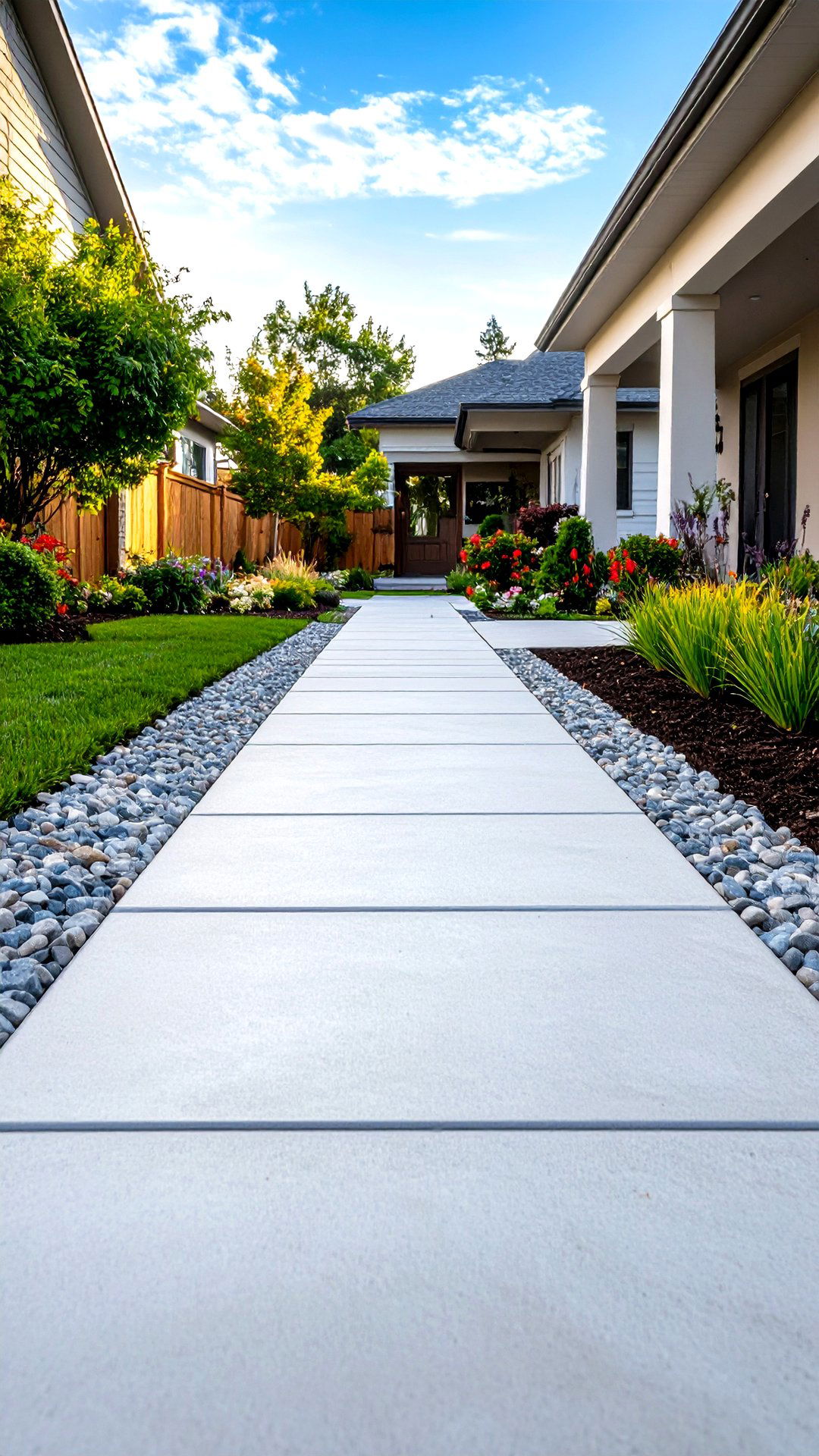
An everyday broom and steady wrist create gentle grooves that add traction and a timeless, clean look to a concrete walkway. Pros recommend dragging the broom after initial set but before final cure to avoid tearing the surface, ensuring the ridges remain crisp and durable. Because the finish is quick, inexpensive, and resists slipping even when wet, it’s ideal for high-traffic front entries. Seal annually to keep dirt from lodging in the lines and to resist freeze-thaw cycling.
2. Stamped Concrete Walkway That Imitates Stone
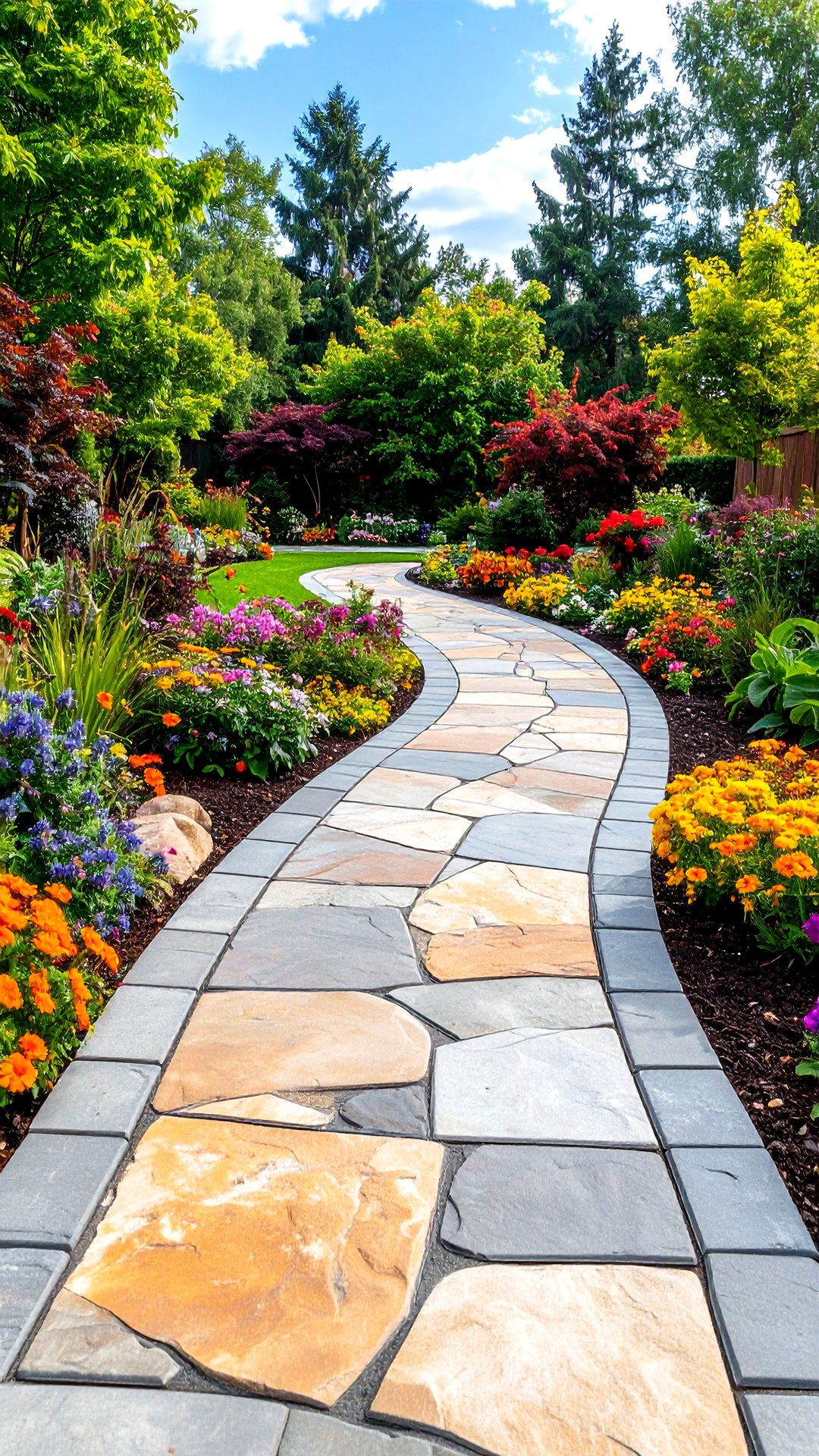
If you love flagstone but not the cost, choose a stamped concrete walkway — rubber mats pressed into fresh concrete replicate slate, cobble, or brick with astonishing realism. Release powders highlight crevices and deepen color, delivering the charm of quarried rock for roughly half the installed price. Ask your installer for integral color plus powder antiquing so the “grout” reads slightly darker than the “stones. ” Add a penetrating sealer and the surface resists stains and de-icing salts yet looks hand-chiseled.
3. Exposed Aggregate Concrete Walkway
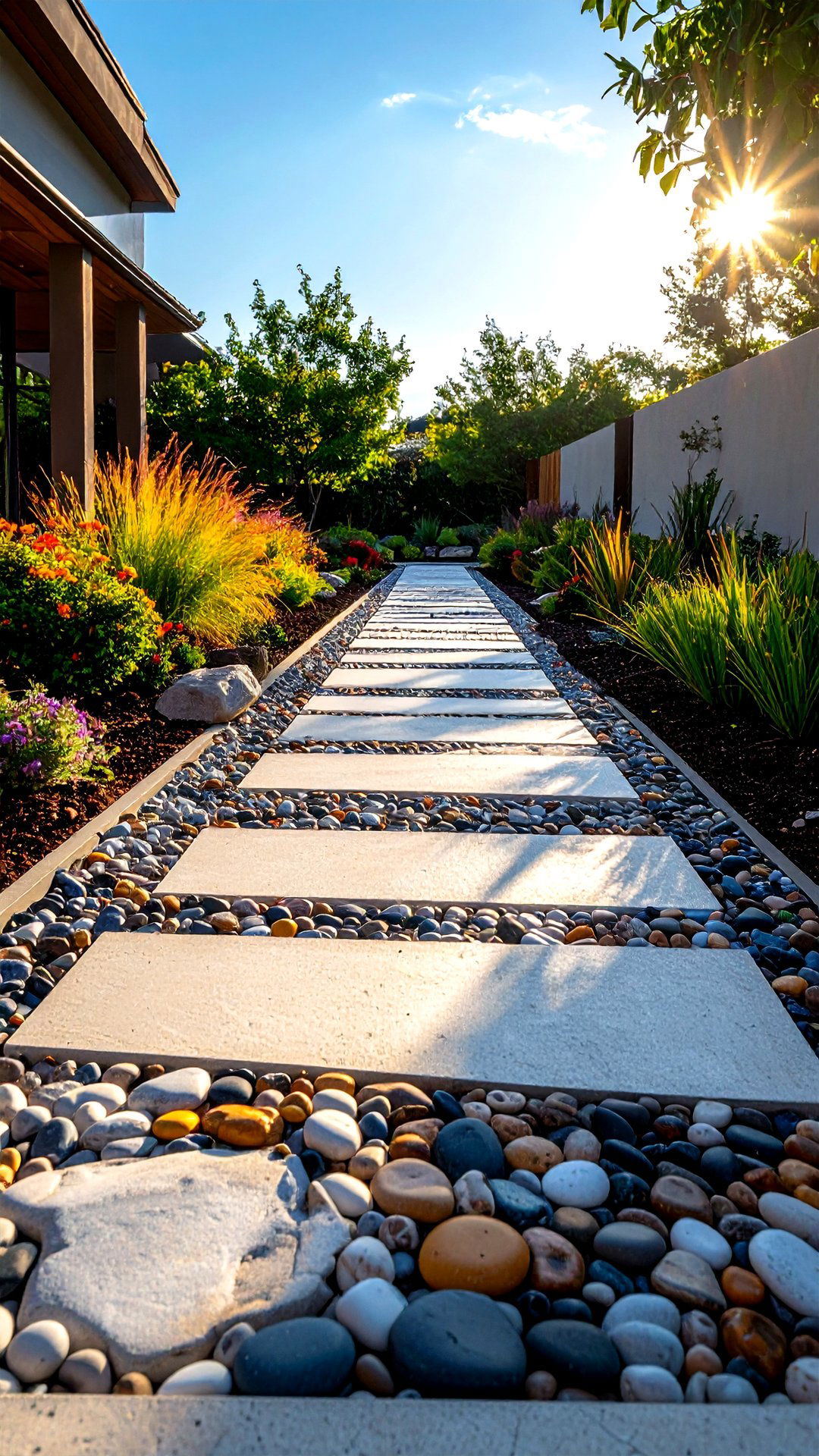
Sprinkling — or “seeding” — polished river pebbles onto wet concrete, then washing off surface paste the next day, yields a mosaic of durable aggregate that sparkles in sun and drains water well. Choose contrasting stone sizes and colors to accent adjacent beds or echo façade masonry. The method adds roughly 20 % to material cost but requires no additional formwork, making it an affordable upgrade. Periodic resealing keeps the stones vivid and the surface easy to hose clean.
4. Integral-Colored Concrete Walkway
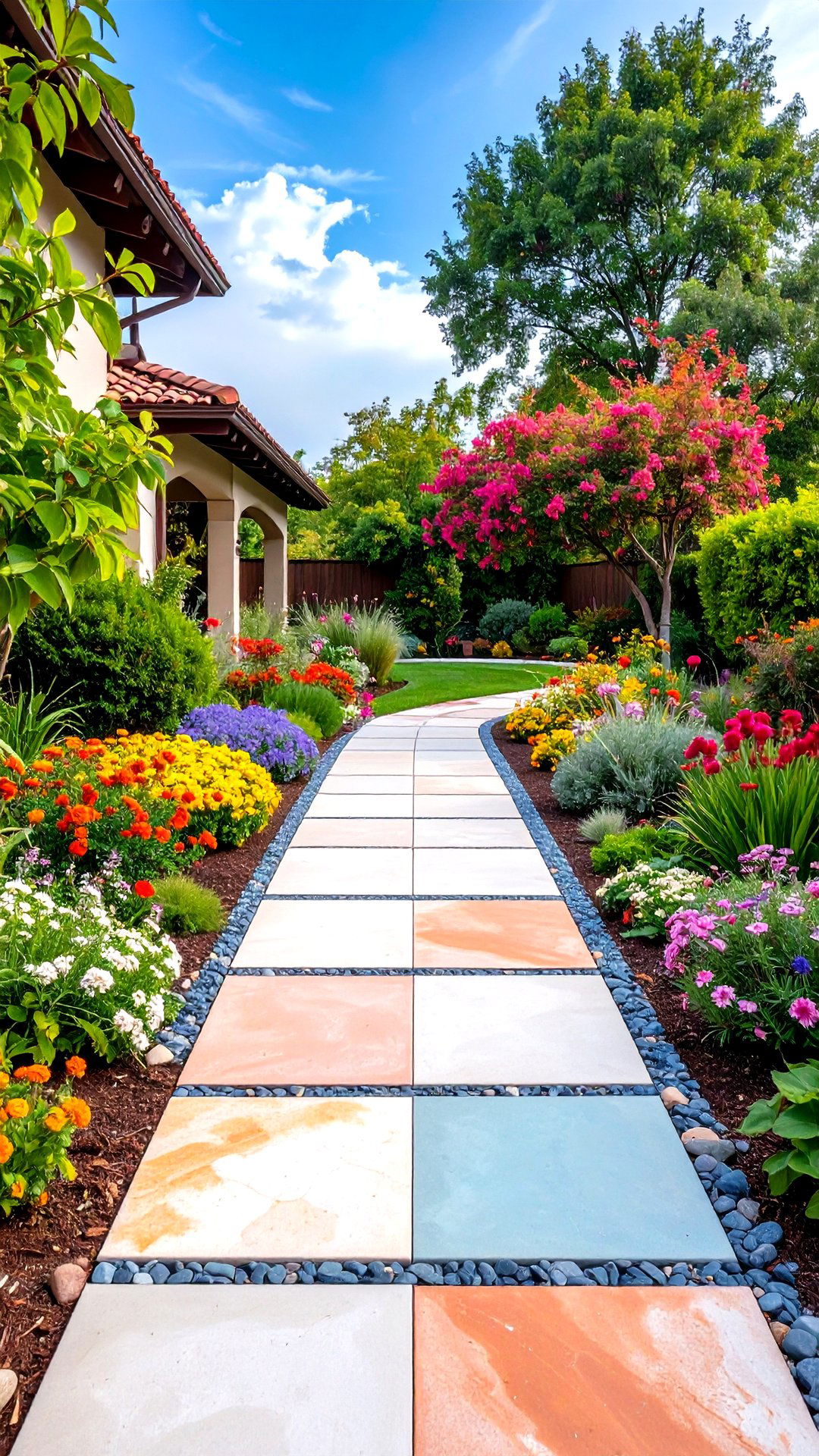
Integral pigments mixed into the truck turn ordinary gray into warm terra-cotta, cool slate, or even pastel blue-green, eliminating future flaking paint. Because color penetrates fully, scratches reveal the same hue beneath. Acid-stain accents or saw-cut borders can layer complementary tones without looking “painted on. ” Specify UV-stable iron-oxide powders for fade resistance and request a mock-up panel to confirm the final shade in site lighting.
5. Concrete Walkway with Decorative Borders
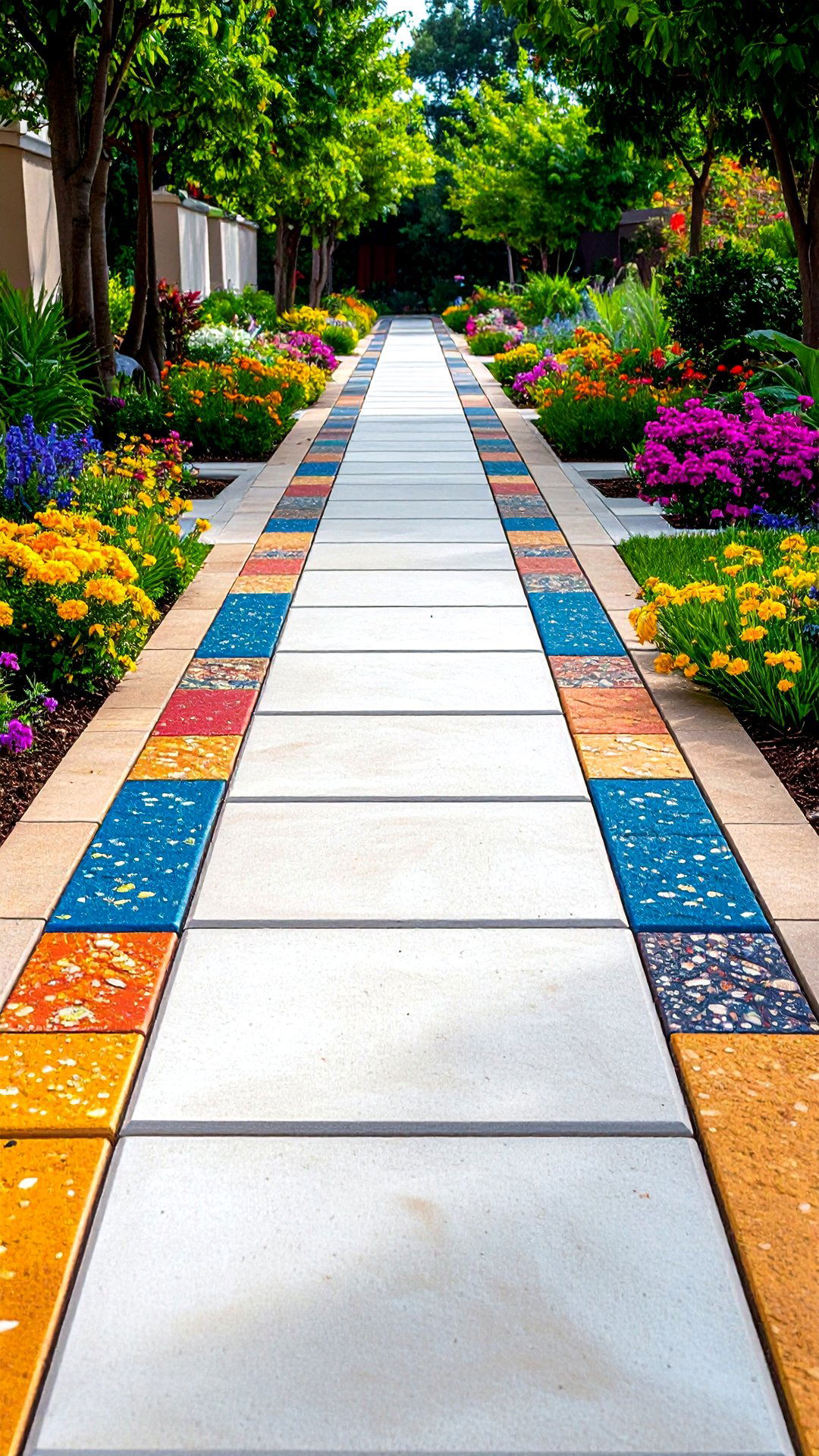
Adding a contrasting band — stamped brick, colored broom finish, or saw-cut 12-inch frame — instantly upgrades a straight concrete walkway. Borders break up expanses, hide minor alignment wiggles, and help tie the path to porch trim or roof fascia colors. Installers often pour the field first, then return with a narrow second pour or an overlay to keep costs modest. For extra polish, tool the joint so border and field sit flush, eliminating toe-catch edges.
6. Graceful Curved Concrete Walkway
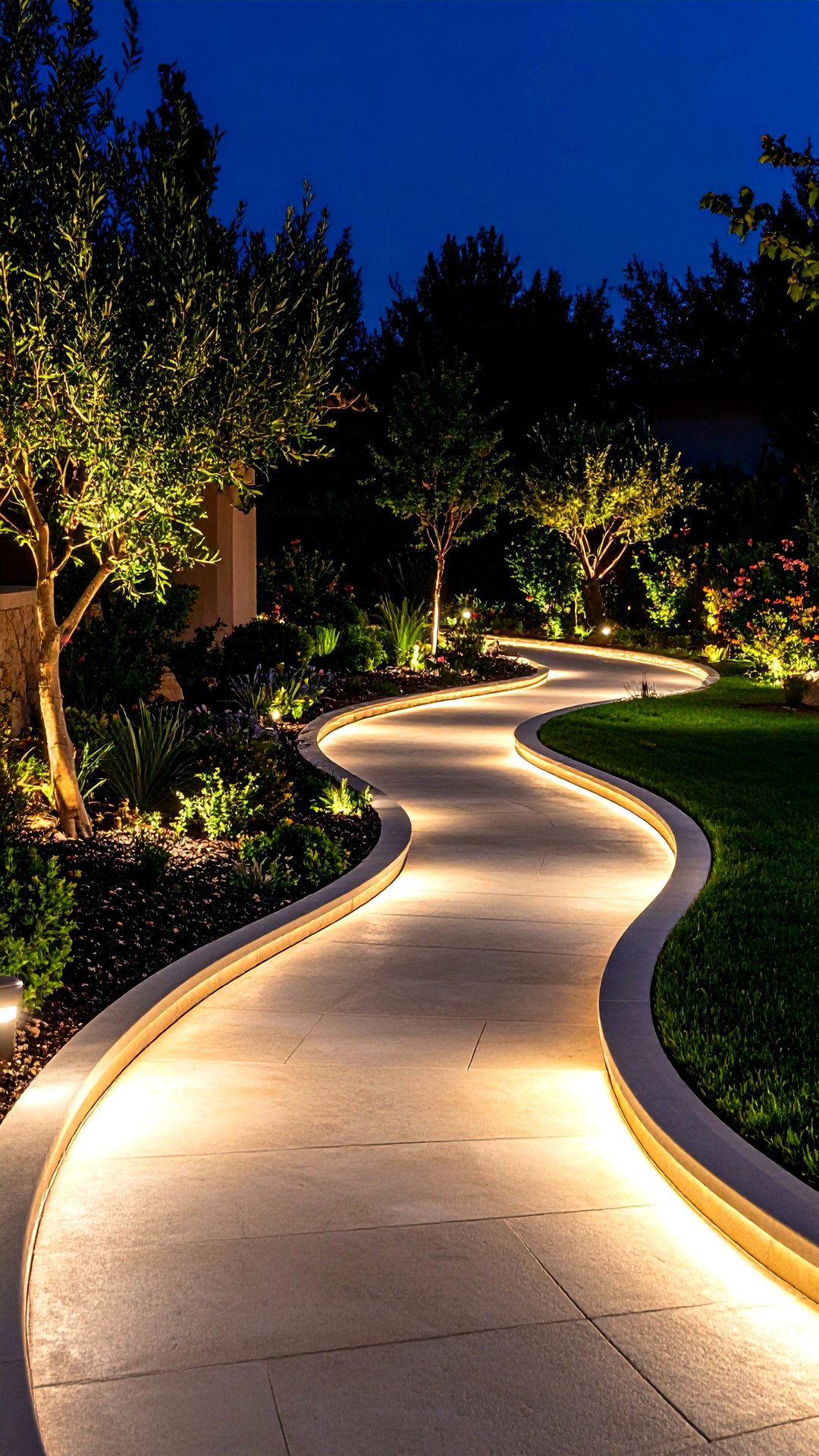
A gentle S-curve invites visitors to slow down and notice your landscaping, and concrete’s plasticity makes curves almost free — just flex ¼-inch plywood inside the forms. Use a two-by-four “spacer stick” to hold consistent width while staking, then radius the finished edges for a professional sweep. Curves disperse runoff, so puddles rarely linger, and small elevation tweaks are simple during forming. Finish with low path lights tucked into bends to emphasize the graceful line at night.
7. Floating-Pad Concrete Walkway
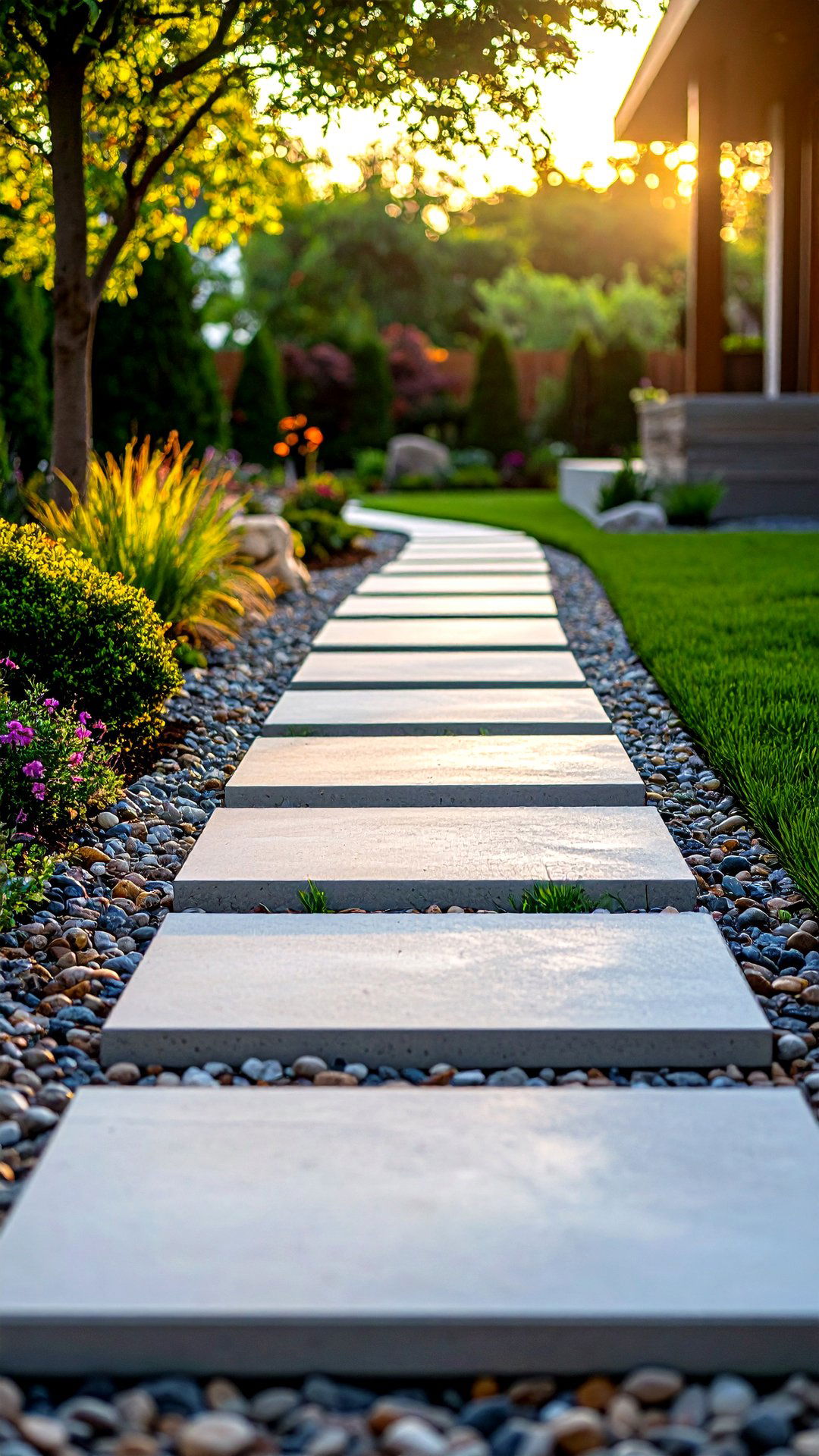
Rather than one monolithic slab, pour individual pads separated by gravel or turf for a modern, “hovering” look that breaks up mass and aids drainage. Architects like 3- to 6-inch gaps filled with Mexican beach pebbles to soften hard edges. Because each pad can move slightly without cracking its neighbor, floating walks perform well on expansive soils. Use fiber-reinforced mixes and plastic sheeting under the pour to keep pads super-smooth on the underside and easy to level.
8. Oversize Stepping-Stone Concrete Walkway
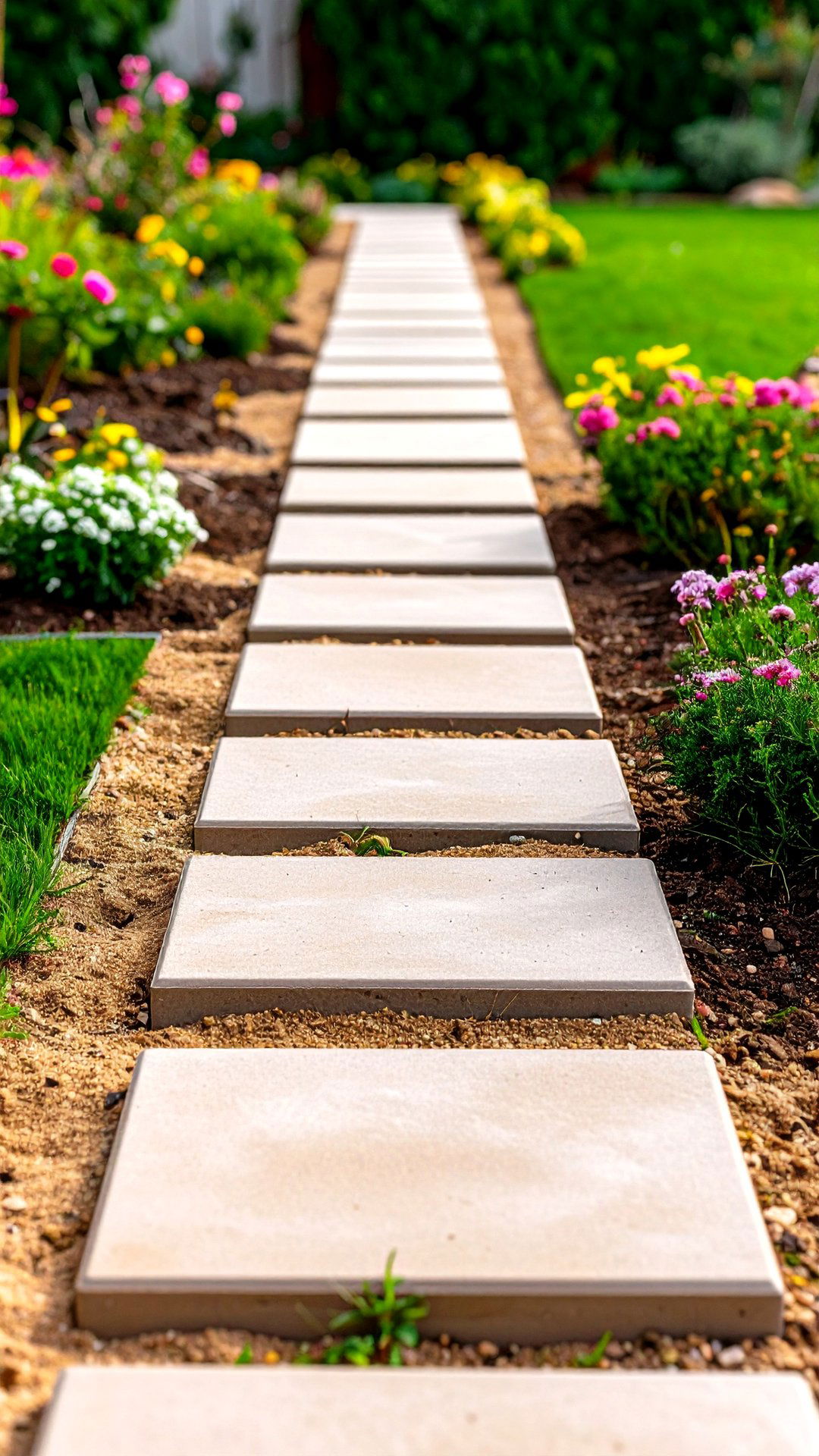
Large square or rectangular slabs set in mulch or lawn read like giant stepping-stones — playful yet refined. Cast the “stones” in reinforced 2-inch-thick molds off-site, then bed them in a compacted sand base for quick installation and easy replacement. Vary spacing so guests naturally pause where the garden view is best. Edge each stone with dwarf mondo grass or thyme to blur hard lines and perfume every step.
9. Permeable Concrete Walkway for Storm-Water Control
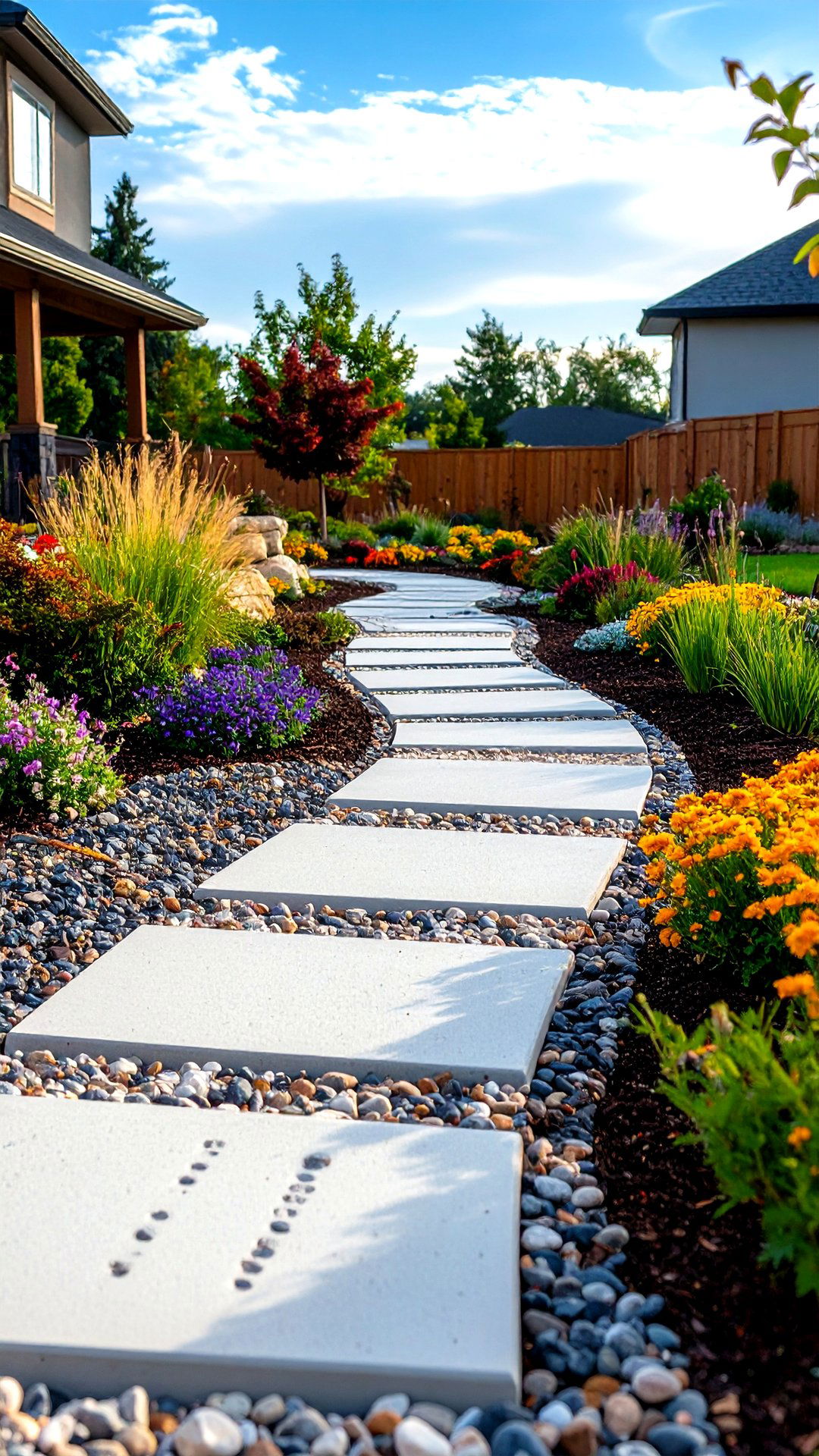
Permeable, or pervious, concrete omits fine sand so rainwater slips through air voids into a gravel base, recharging groundwater and easing runoff. Municipalities increasingly encourage it to reduce burden on storm sewers, and installers can pour it with the same forming methods as standard slabs. Keep slopes gentle (under 5 %) and vacuum annually to clear sediment that might clog pores. The open matrix gives a subtle, contemporary texture while meeting green-building goals.
10. Glow-in-the-Dark Concrete Walkway

Mixing photoluminescent glass aggregate into a concrete walkway turns the path into a soft blue-green runway after dusk — no wires required. During the day the stones appear off-white; at night they emit eight to ten hours of calming glow, perfect for way-finding without harsh fixtures. Use clear sealers so UV light can charge the aggregate, and place the mix only ½-inch deep to keep the costly glow stones economical.
11. Concrete Walkway with Built-In Lighting Channels
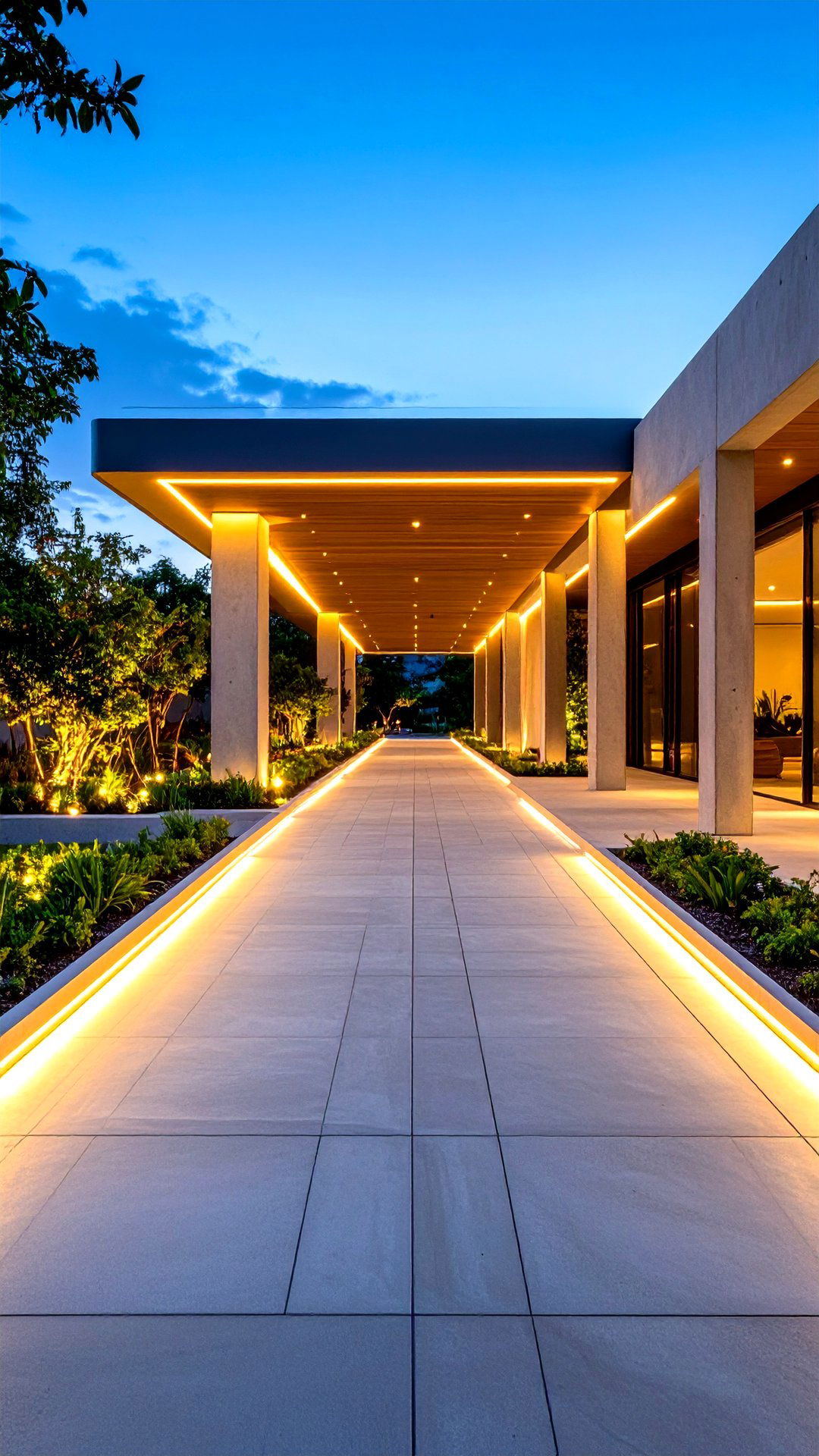
Slip low-voltage LED tape into saw-cut recesses along each edge, trowel thin-set over the cables, and you have a concrete walkway that lights itself from within. Designers caution against “runway” brightness; instead, set drivers to warm-white and stagger fixtures to avoid glare. Recessed lighting eliminates fixture maintenance and protects wires from lawn equipment, while layered illumination accentuates texture and boosts security.
12. Concrete Walkway with Contrasting Edging
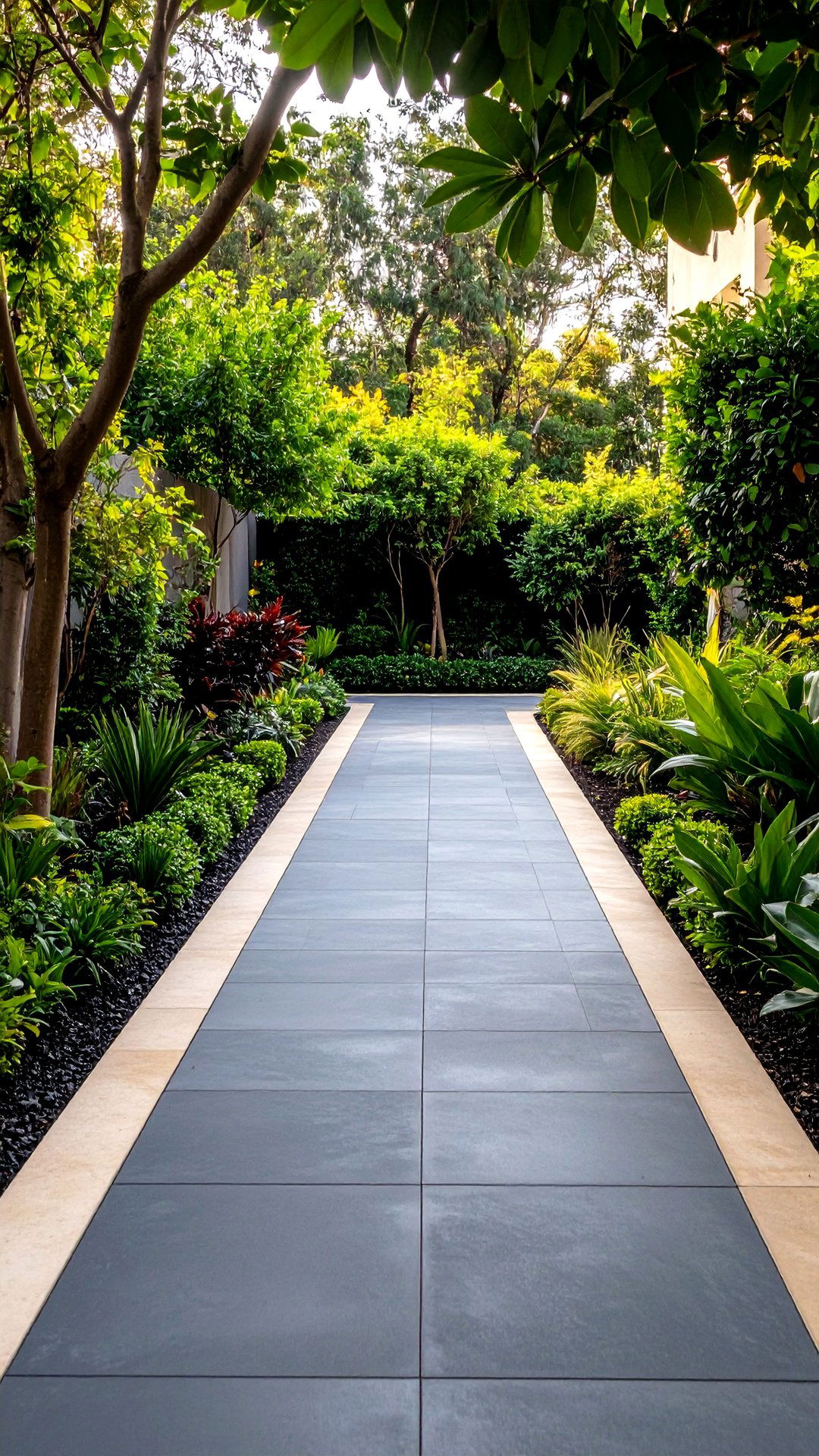
Pour the center field in cool charcoal and the edges in sandy buff, or simply tool a deep joint and stain the border afterward — either way the crisp outline frames plantings and guides the eye. Landscapers often pair smooth borders with textured centers for subtle complexity that hides footprints. Choose a color that echoes roof shingles or shutters so the walk feels intentional, not busy.
13. Pebble-Mosaic Concrete Walkway
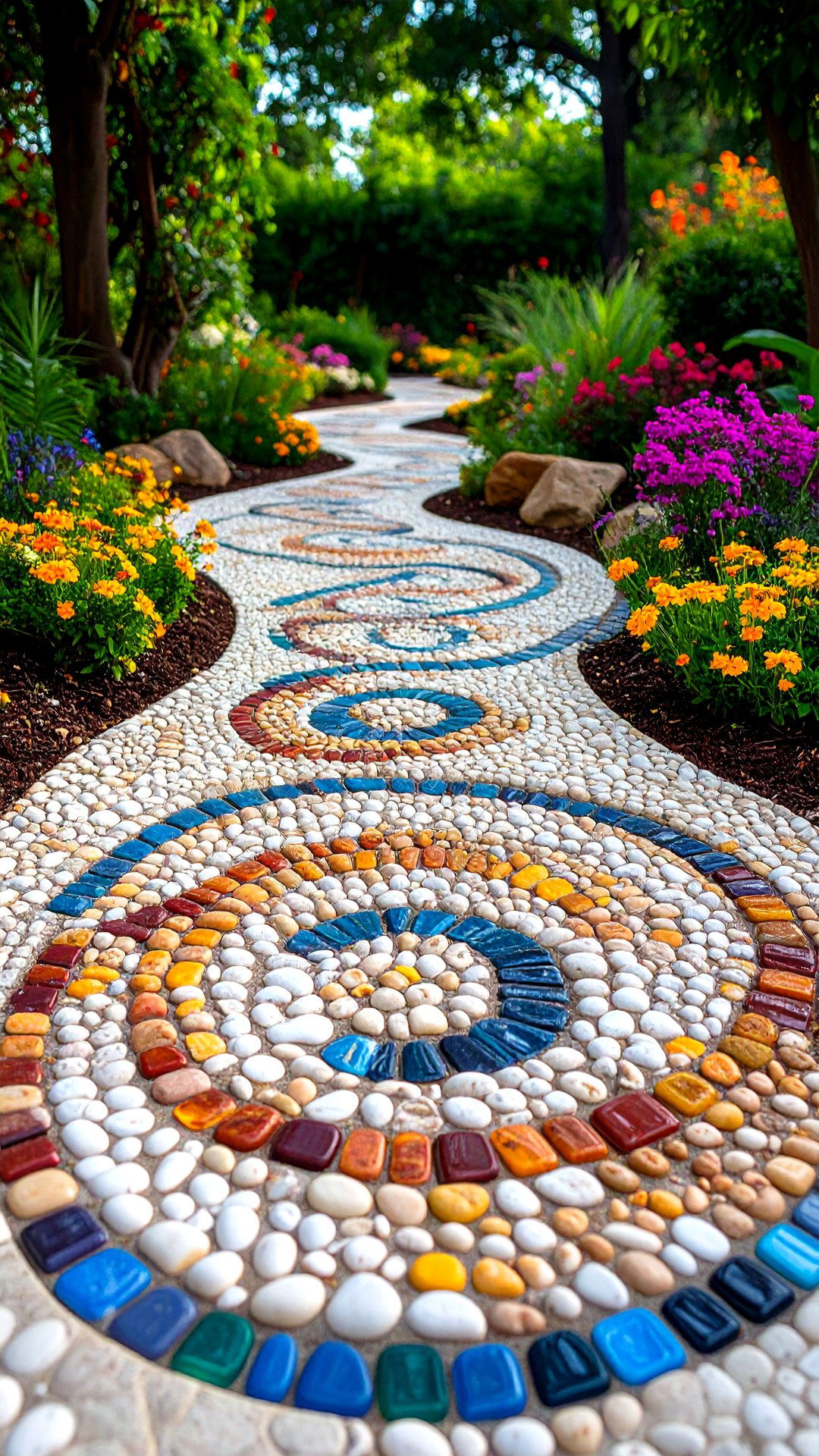
Press polished pebbles, recycled glass, or even sea shells into fresh concrete to craft a personalized riverbed ribbon. A simple wood float seats the pieces flush so snow shovels won’t snag. Patterns — spirals, mandalas, family initials — turn a necessity into storytelling art. Seal every two to three years to lock small stones in place and deepen colors. The technique is budget-friendly and perfect for leftover concrete at the end of a pour.
14. Geometric-Score Concrete Walkway
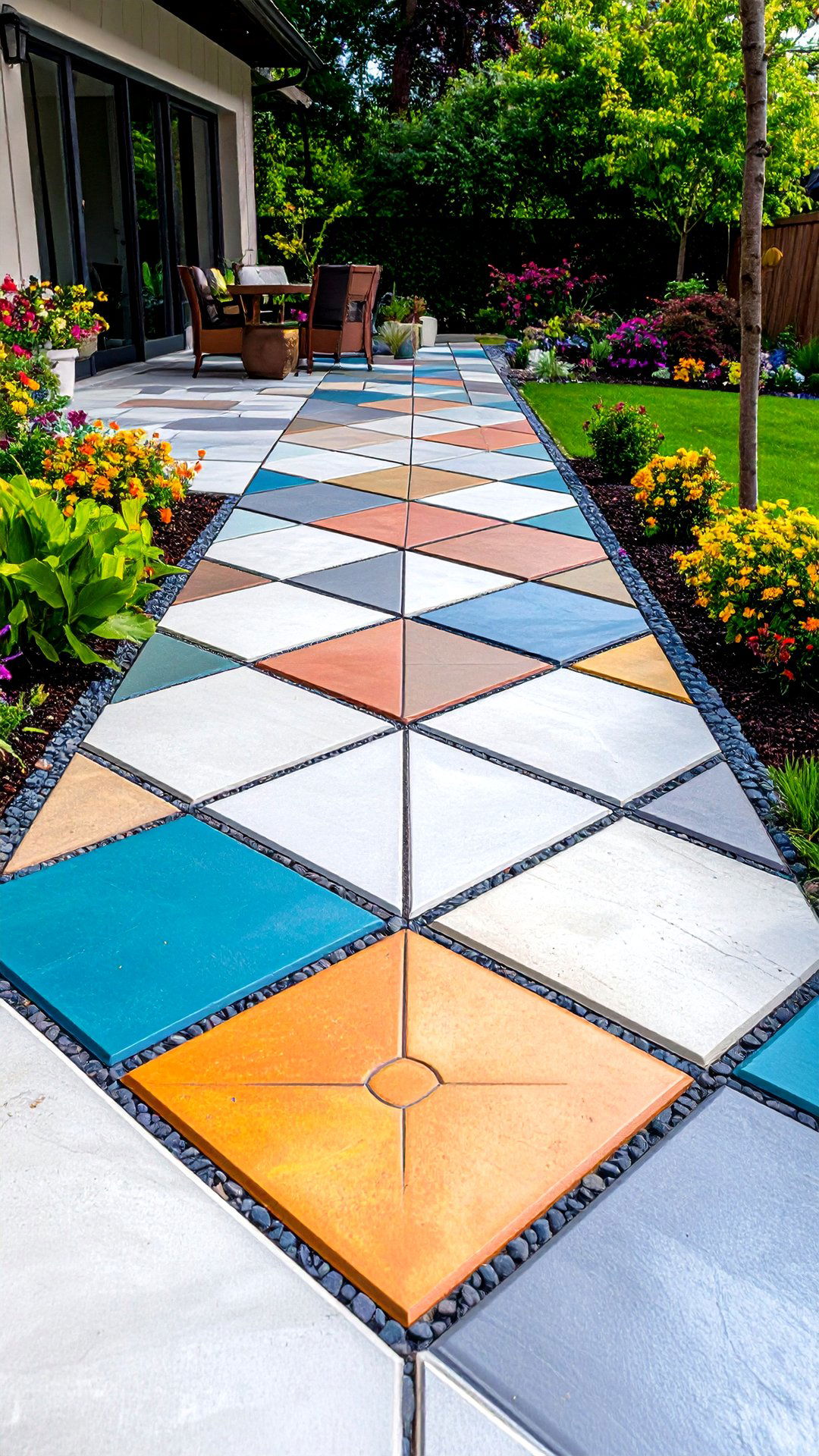
Saw-cutting a grid of 3-foot squares after cure converts a plain concrete walkway into a chic tiled boulevard. Fill joints with colored urethane sealant to prevent weed intrusion and highlight lines. Designers often offset the grid diagonally to front doors for extra drama. The deep scores also act as controlled-crack joints, boosting durability where freeze-thaw cycles are severe.
15. Ribbon-Planter Concrete Walkway
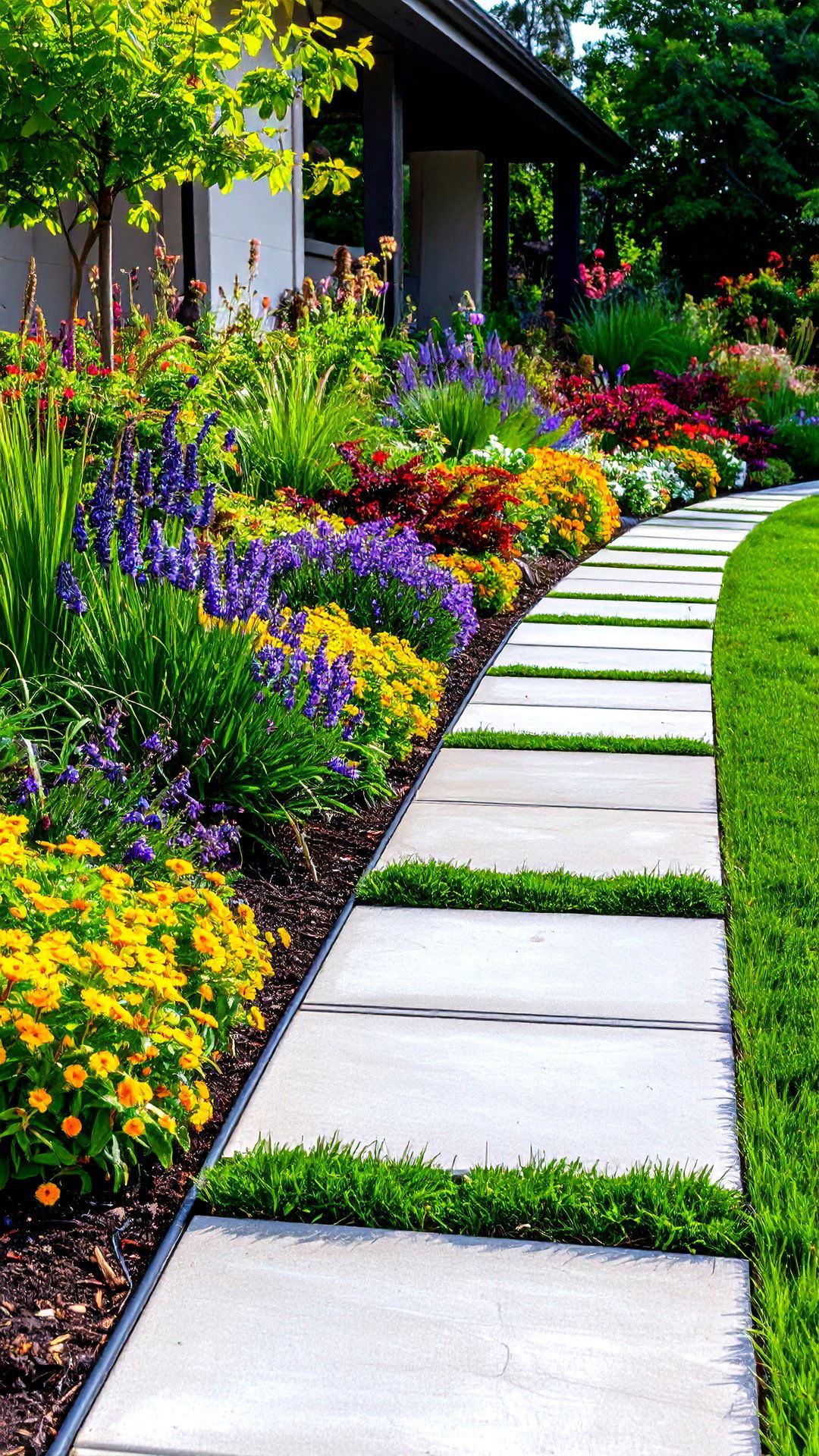
Alternate 2-foot concrete bands with 18-inch planting strips, and your walkway doubles as a linear garden. Perennials soften hardscape while the concrete provides firm footing. Choose drought-tolerant herbs or ornamental grasses that sway without spilling over the path. Keep root barriers at slab edges so soil movement doesn’t jack the concrete, and install drip irrigation to simplify water delivery.
16. Grass-Joint Concrete Paver Walkway
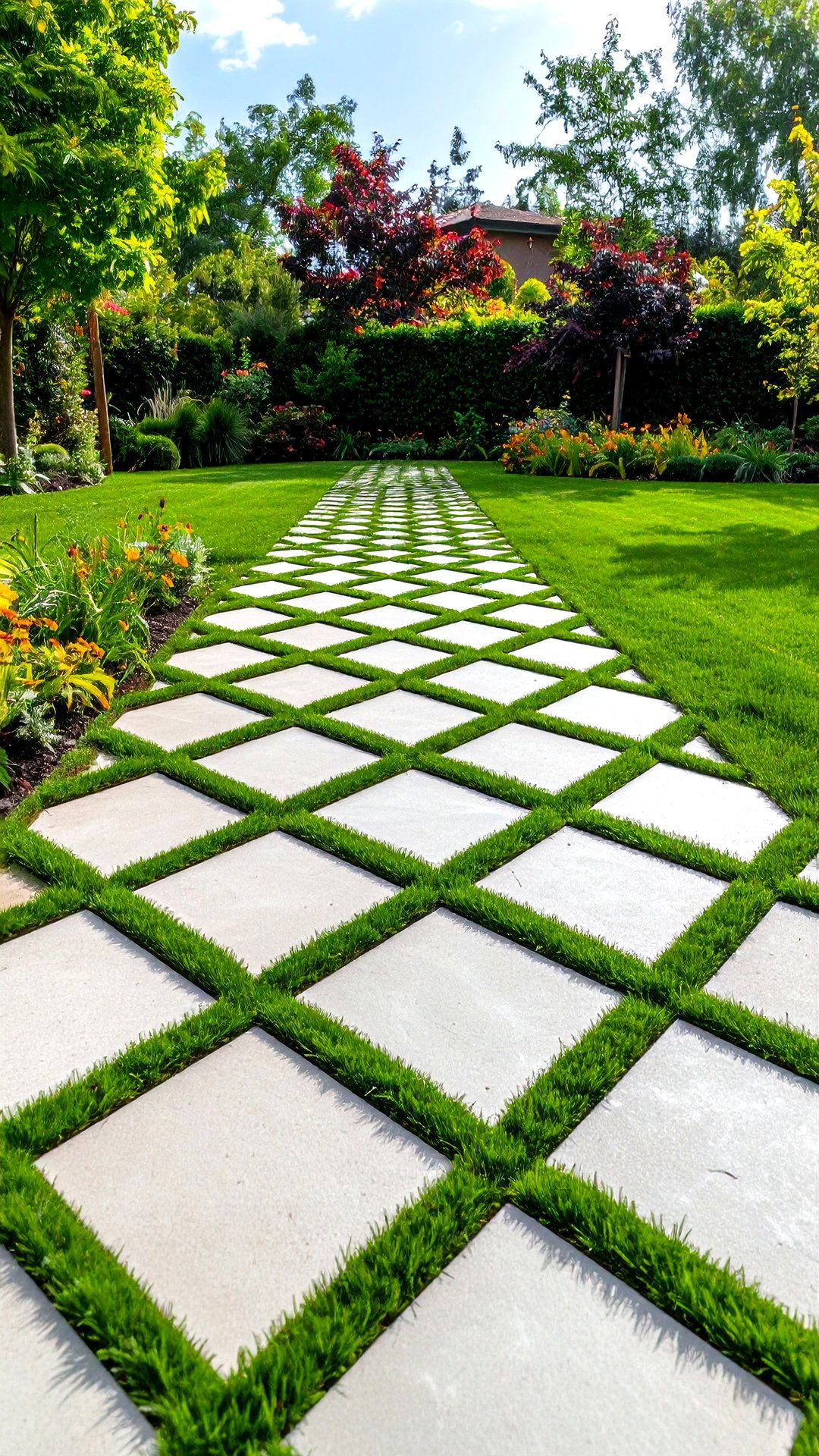
Wide pavers separated by narrow turf joints lend a “lawn chessboard” vibe that blends hardscaping with greenery. Mow-strip edges make maintenance easy, while synthetic grass inserts are an option for arid climates. Level, compacted base is key so soil under the sod stays put when watered. The living joints lower surface temperature, making the walk cooler underfoot.
17. Mid-Century Modern Concrete Walkway
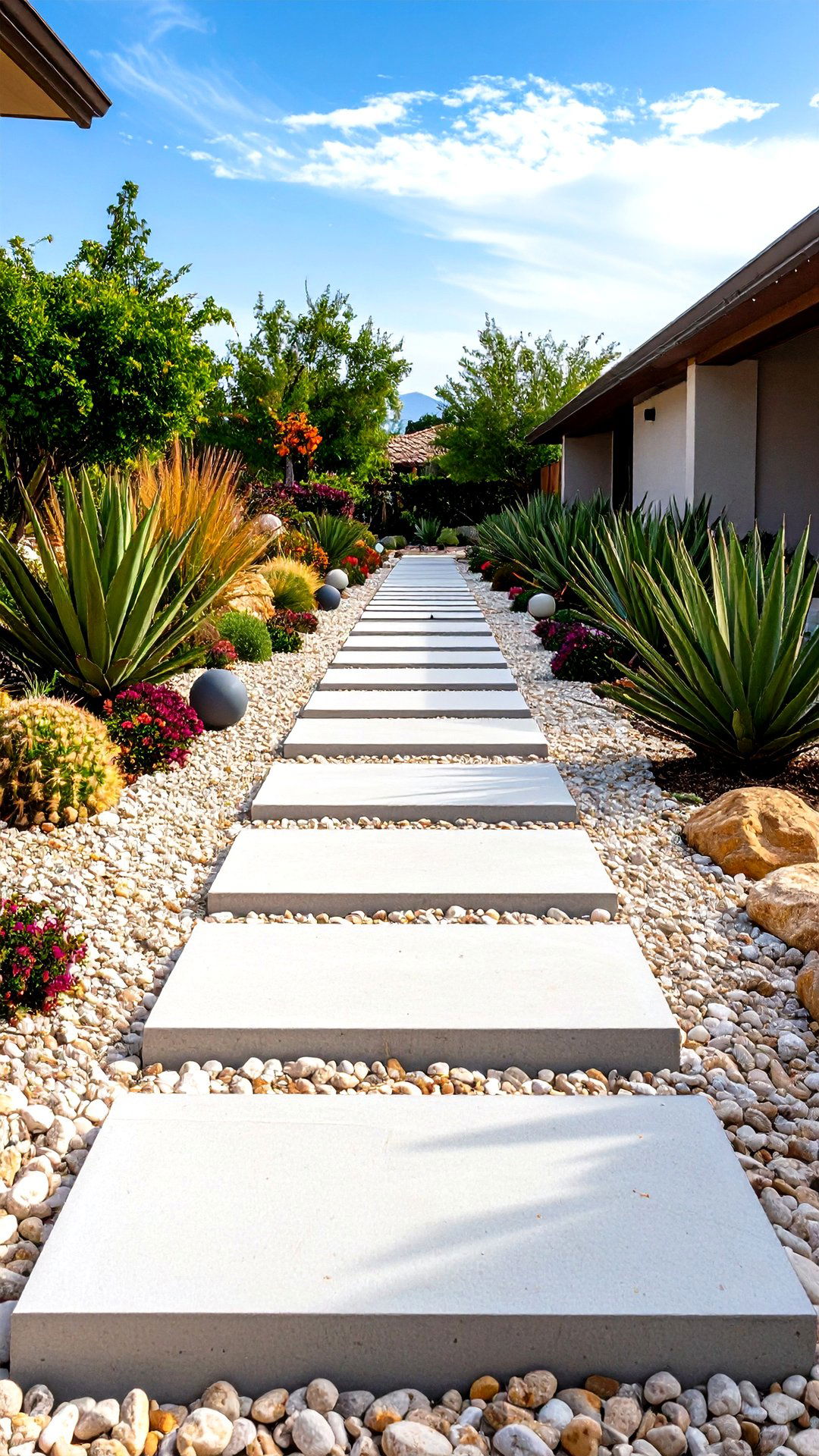
Think generous rectangular pads floating in gravel, flanked by cycads or agaves, all in a restrained palette of gray and black — hallmarks of mid-century curb appeal. Keep joints perfectly parallel to the home’s main axis and chamfer corners for a sleek, furniture-like edge. Use retro globe bollards for low lighting that respects the era’s style.
18. Wood-Plank-Textured Concrete Walkway
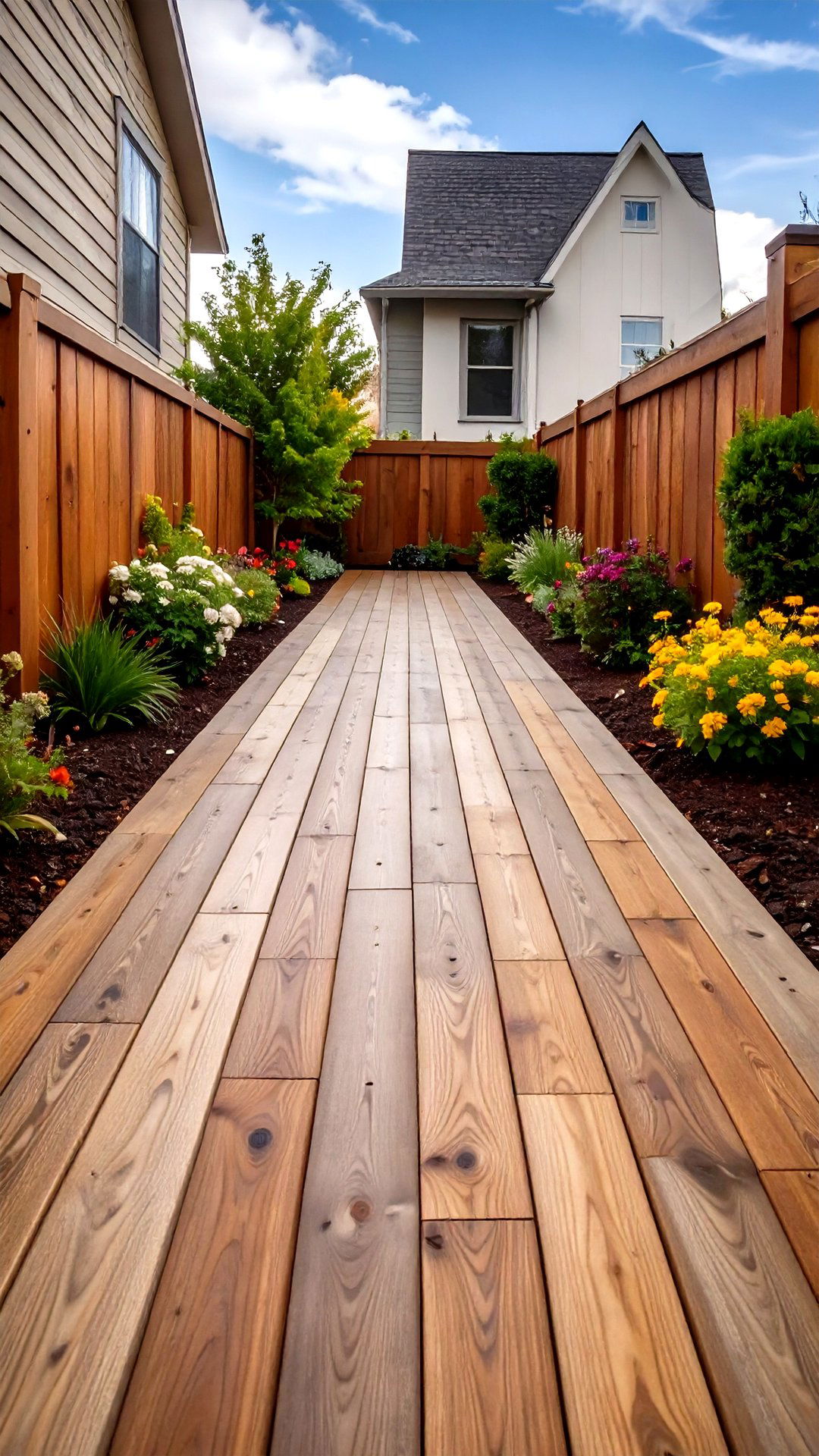
Specialty stamps imprint straight-grained cedar or rustic barn-wood textures into concrete, producing a walkway that looks like timber without rot or termites. Integral earth-brown pigment followed by dark-walnut wash highlights the faux grain. Apply matte sealer to avoid plastic shine and include anti-skid grit for rainy climates. This option pairs beautifully with farmhouse façades and board-and-batten siding.
19. Acid-Stained Artistic Concrete Walkway
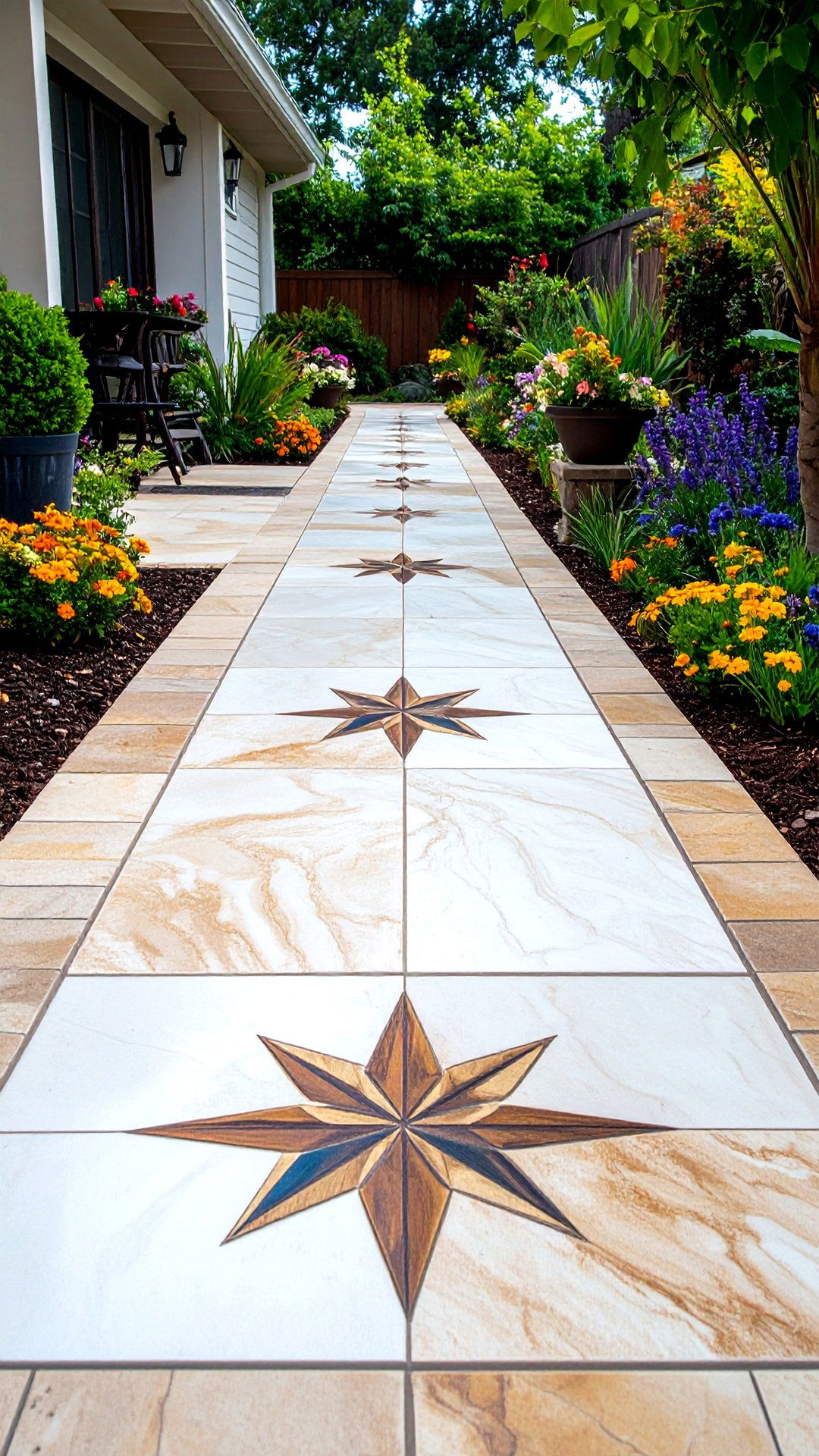
Spraying diluted acid stain onto cured concrete produces marbled, variegated color that never peels because the reaction happens inside the surface. Layer multiple hues, then neutralize and seal for a depth rivaling polished stone. Designers often lay plastic stencils before staining to create leaf silhouettes or compass roses without extra pours. Stain works on old slabs too, making it a smart facelift for dated walks.
20. Snow-Melt Heated Concrete Walkway
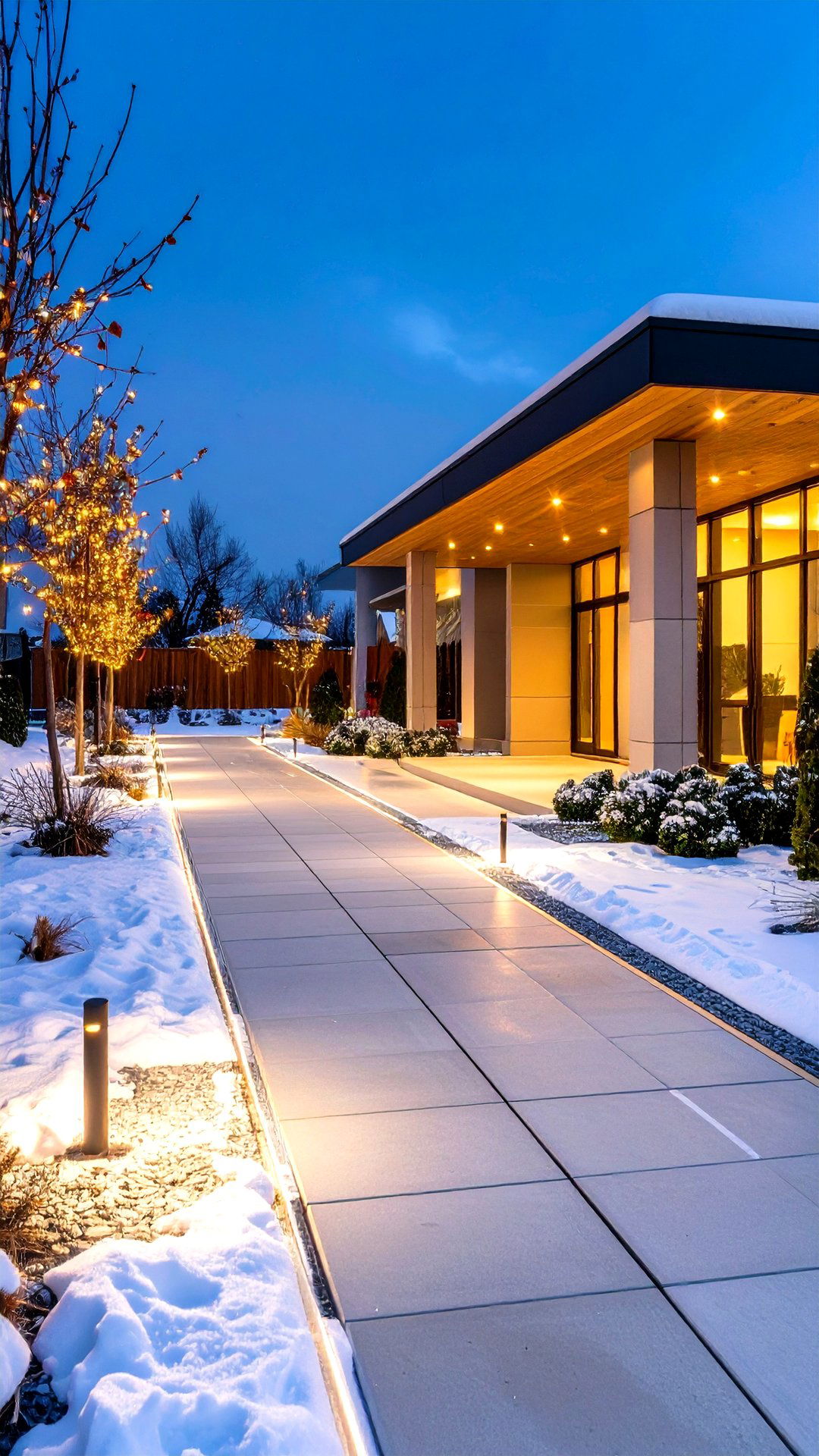
Embedded electric cables or hydronic tubes gently warm the concrete walkway, melting snow before shovels are even considered. Design loads run 36 – 50 watts per square foot, so plan for dedicated circuits or boiler loops. Although installation raises upfront cost, the system prevents freeze-thaw damage and slip-and-fall liability, making it popular in snowy regions. Programmable sensors activate heat only when needed, trimming energy bills.
21. Swirl-Finish Slip-Resistant Concrete Walkway
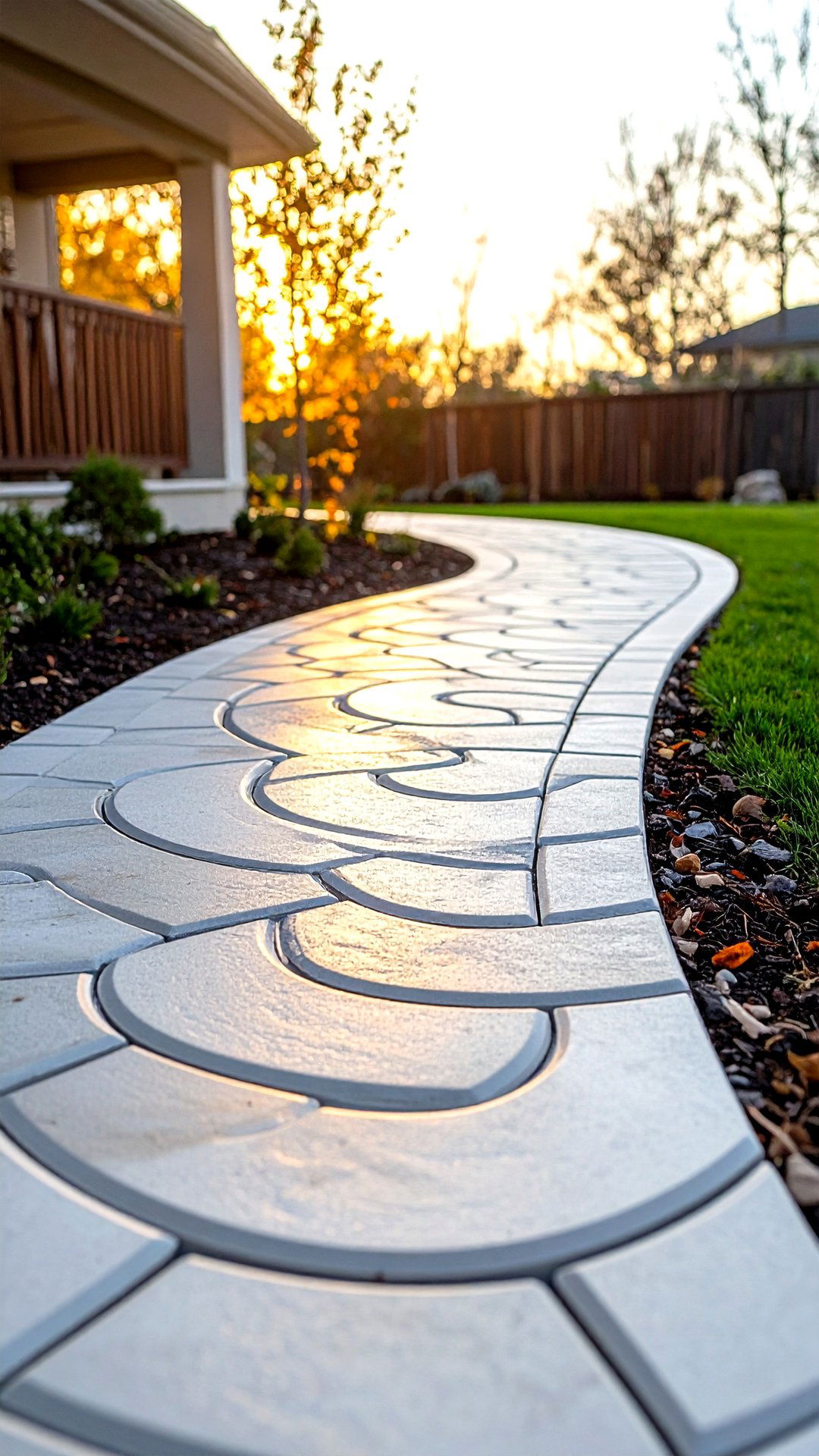
Dragging a stiff broom in tight half-circles leaves an elegant swirl that outperforms straight grooves on slopes. Concrete pros recommend a soft fan pattern so shoes grip from any angle, critical near pool areas or steep drives. Add a penetrating silicone sealer to repel salt without adding gloss, and you’ll have a low-maintenance, high-traction surface for decades.
22. Recycled-Glass Eco Concrete Walkway
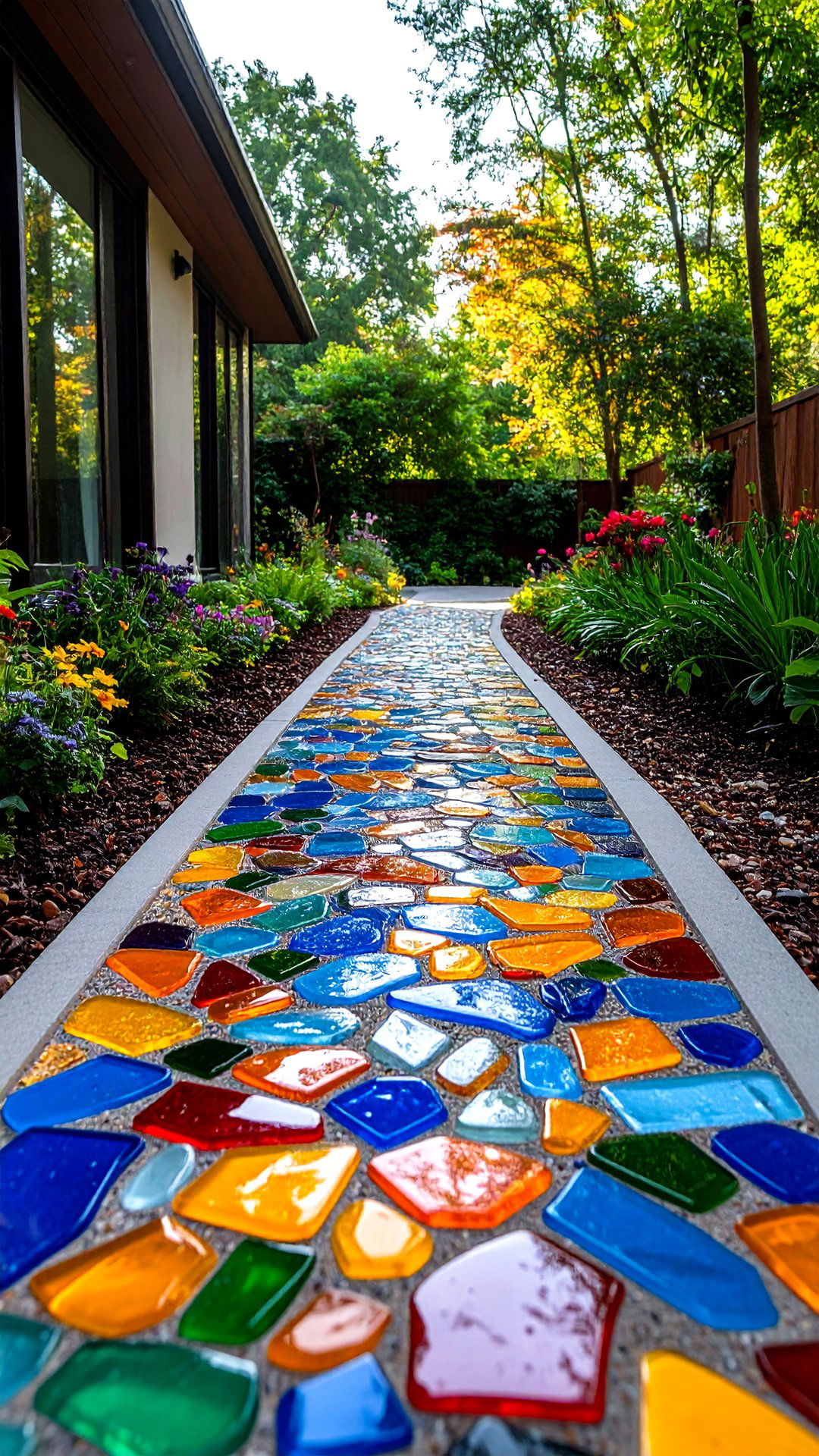
Crushed post-consumer glass bound in clear resin or mixed into pervious concrete yields a speckled, jewel-like walkway that diverts waste from landfills. Colors range from amber beer-bottle browns to cobalt blues — pick hues that echo nearby flowers or trim. The porous binder lets rain soak through, enhancing sustainability, and the glass is tumbled, not sharp, so it’s safe for bare feet.
23. Leaf-Imprint Concrete Walkway
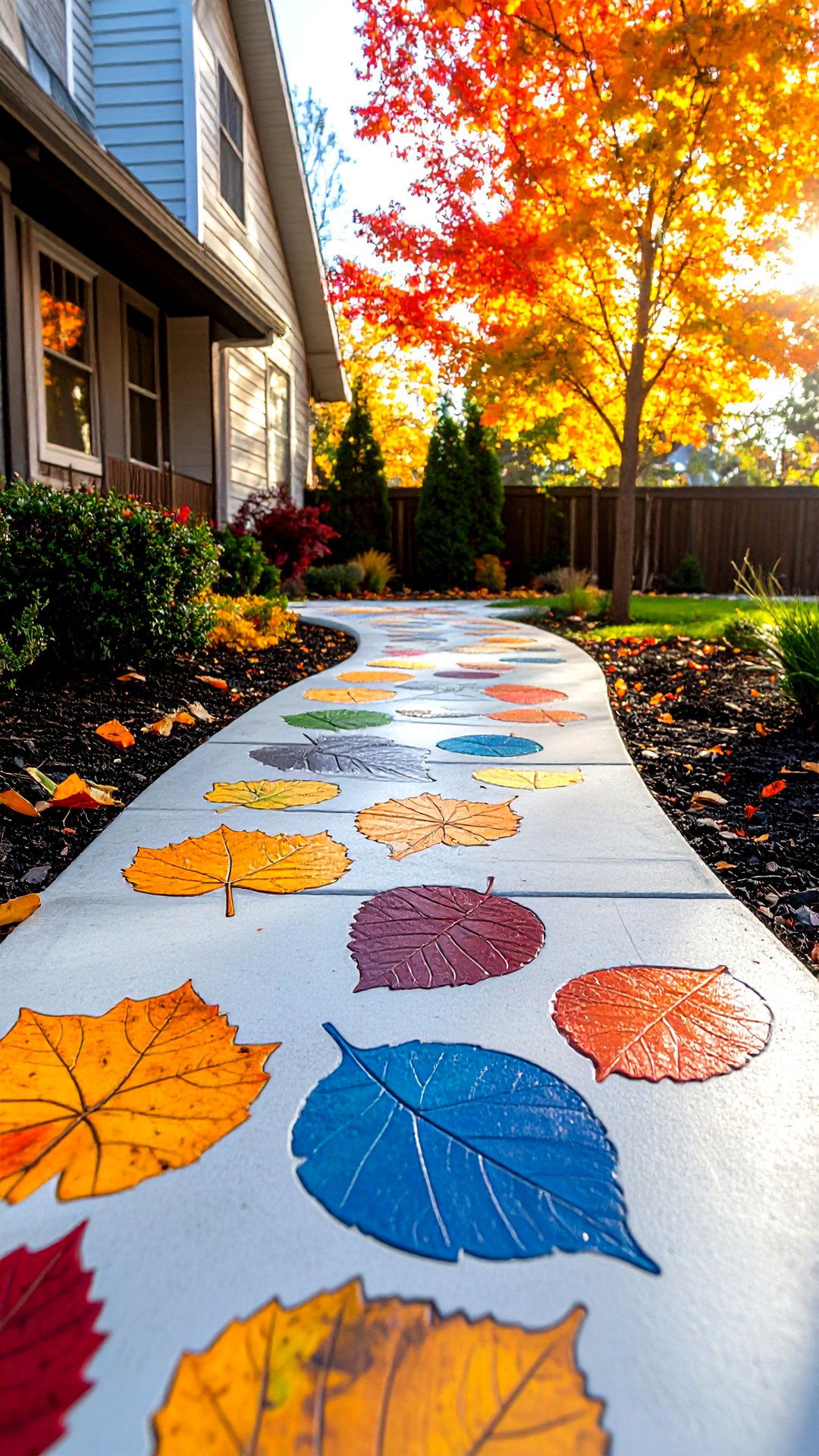
Pressing real fern or maple leaves into soft concrete, then removing them after a light set, creates fossil-like impressions that celebrate surrounding flora. Highlight the veins with a translucent stain for botanical artwork underfoot. Kids enjoy helping collect leaves, making this idea perfect for family DIY projects. Use a silica-sand sealer so impressions remain crisp and easy to rinse clean.
24. Seamless-Texture-Skin Concrete Walkway
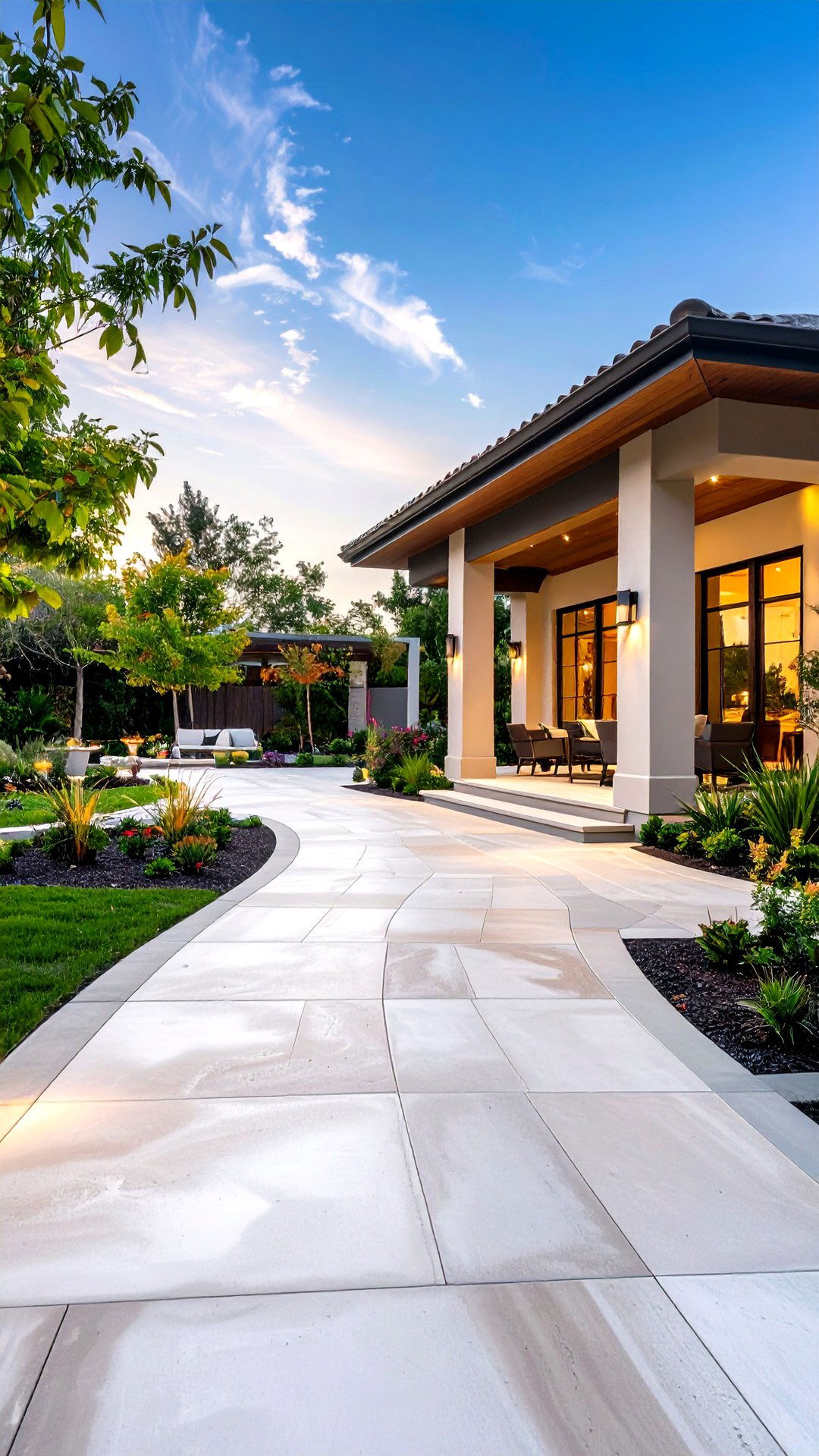
Texture skins impart stone-like surface without joints, giving the illusion of one continuous boulder sliced into walkway form. Because there’s no pattern alignment, installers work fast, cutting labor costs. Seamless textures pair well with modern homes that favor broad, uninterrupted planes. Finish with a light color wash to accent highs and lows, then apply non-yellowing acrylic sealer for long-term clarity.
25. Rock-Salt-Finish Concrete Walkway
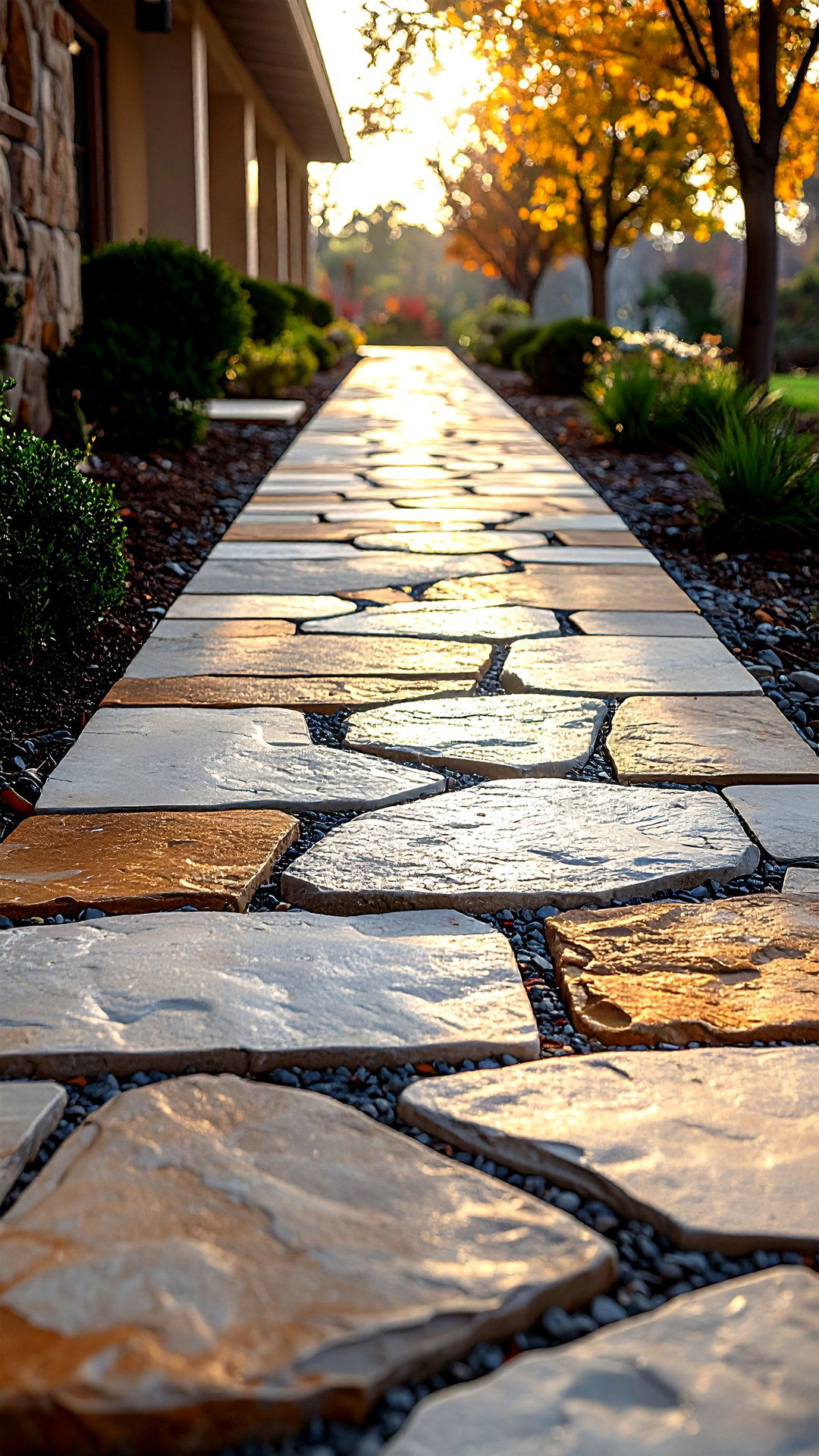
Broadcasting coarse rock salt onto wet concrete, troweling it in, and power-washing a day later leaves tiny craters resembling weathered limestone — subtle, slip-resistant, and inexpensive. This heritage finish suits Craftsman and Mediterranean architecture alike and costs little more than a broom finish. Combining salt finish with integral color or borders elevates the rustic texture into a bespoke statement walkway.
Conclusion:
Whether you crave mid-century minimalism, cottage-style curves, or cutting-edge luminescence, concrete walkways can deliver form, function, and flair on almost any budget. By mixing finishes, adding color, embedding technology, or simply shaping slabs creatively, you transform a utilitarian path into a durable focal point that complements architecture and landscape alike. Let these 25 concrete walkway ideas spark plans that guide every step with style and resilience.


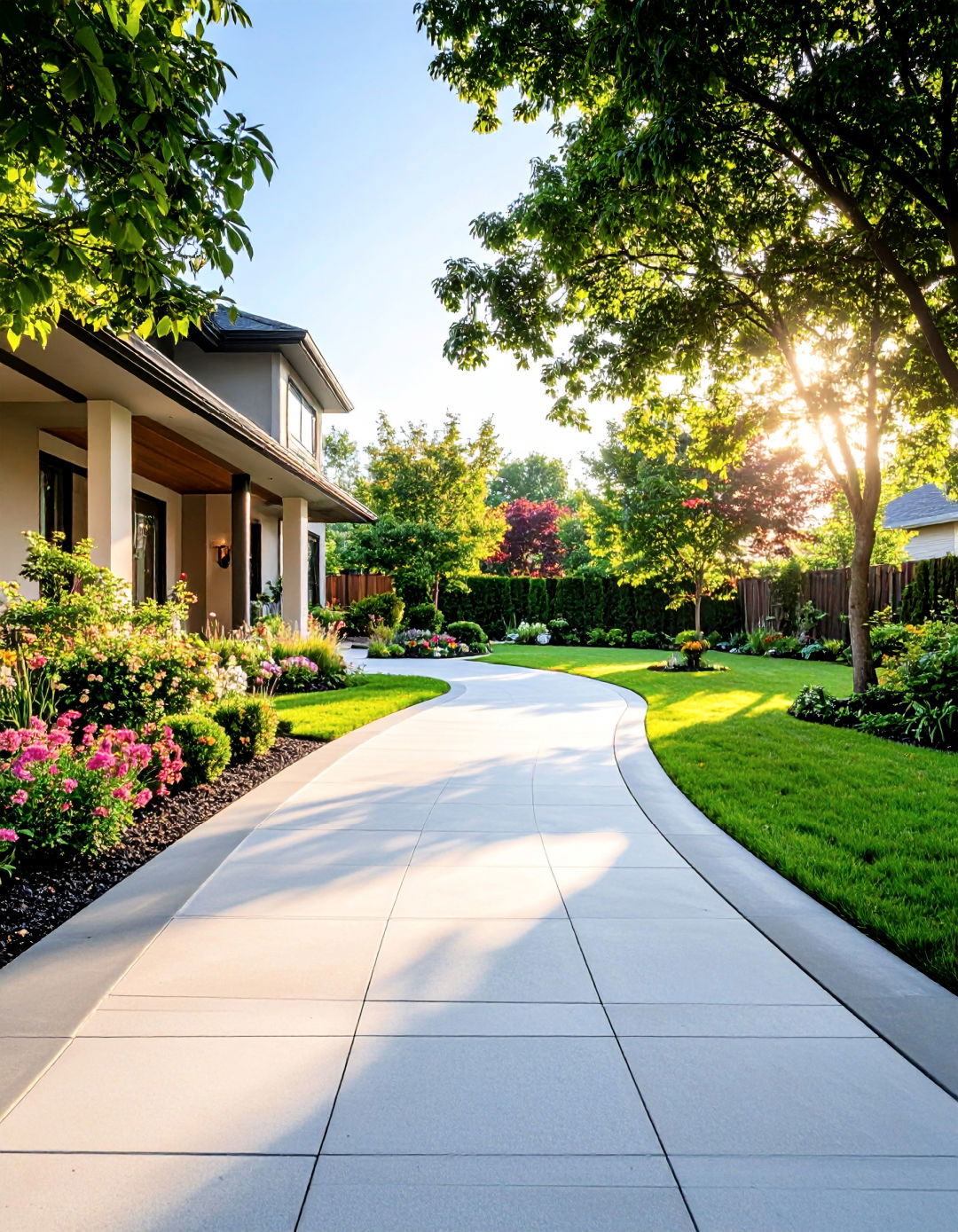

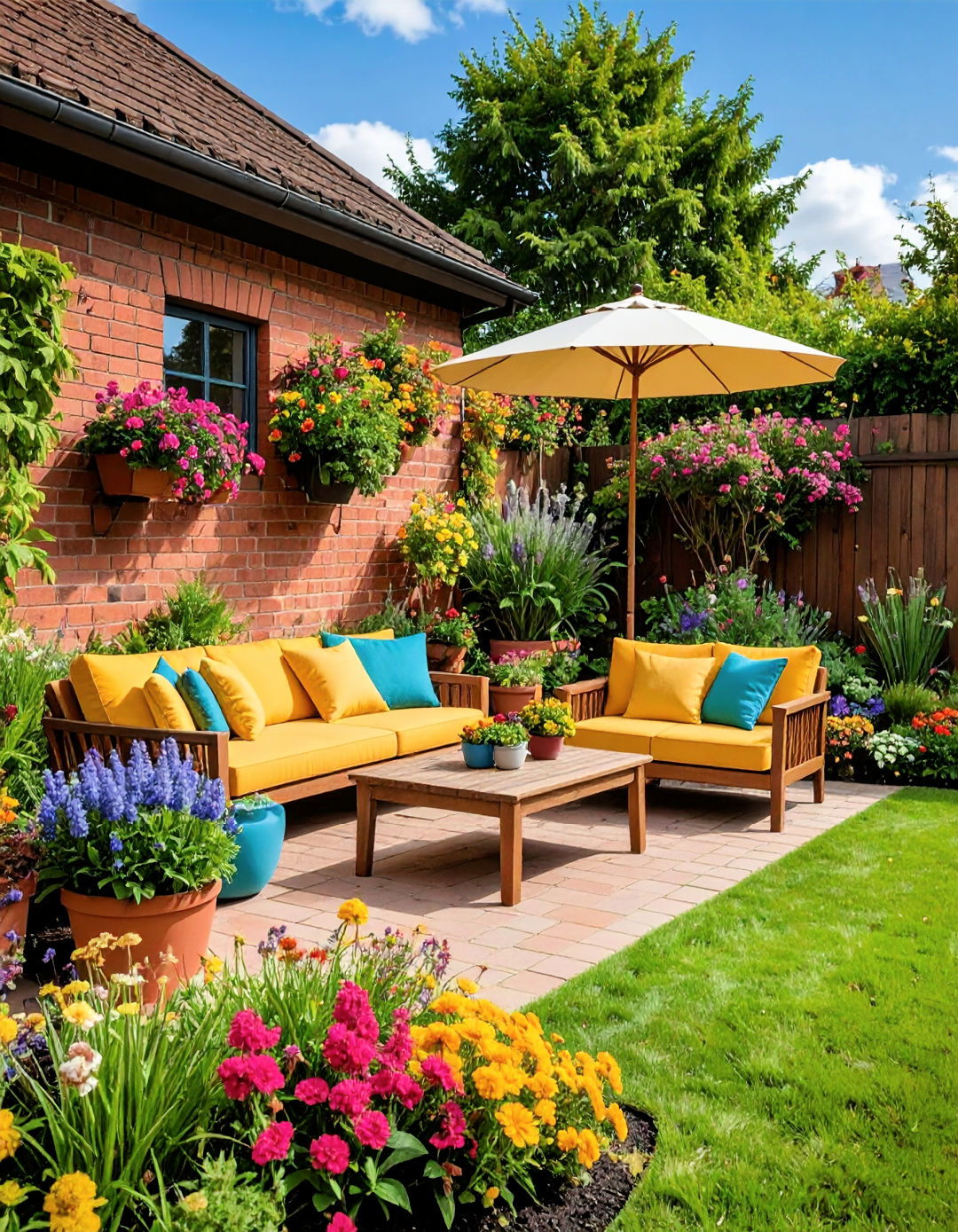
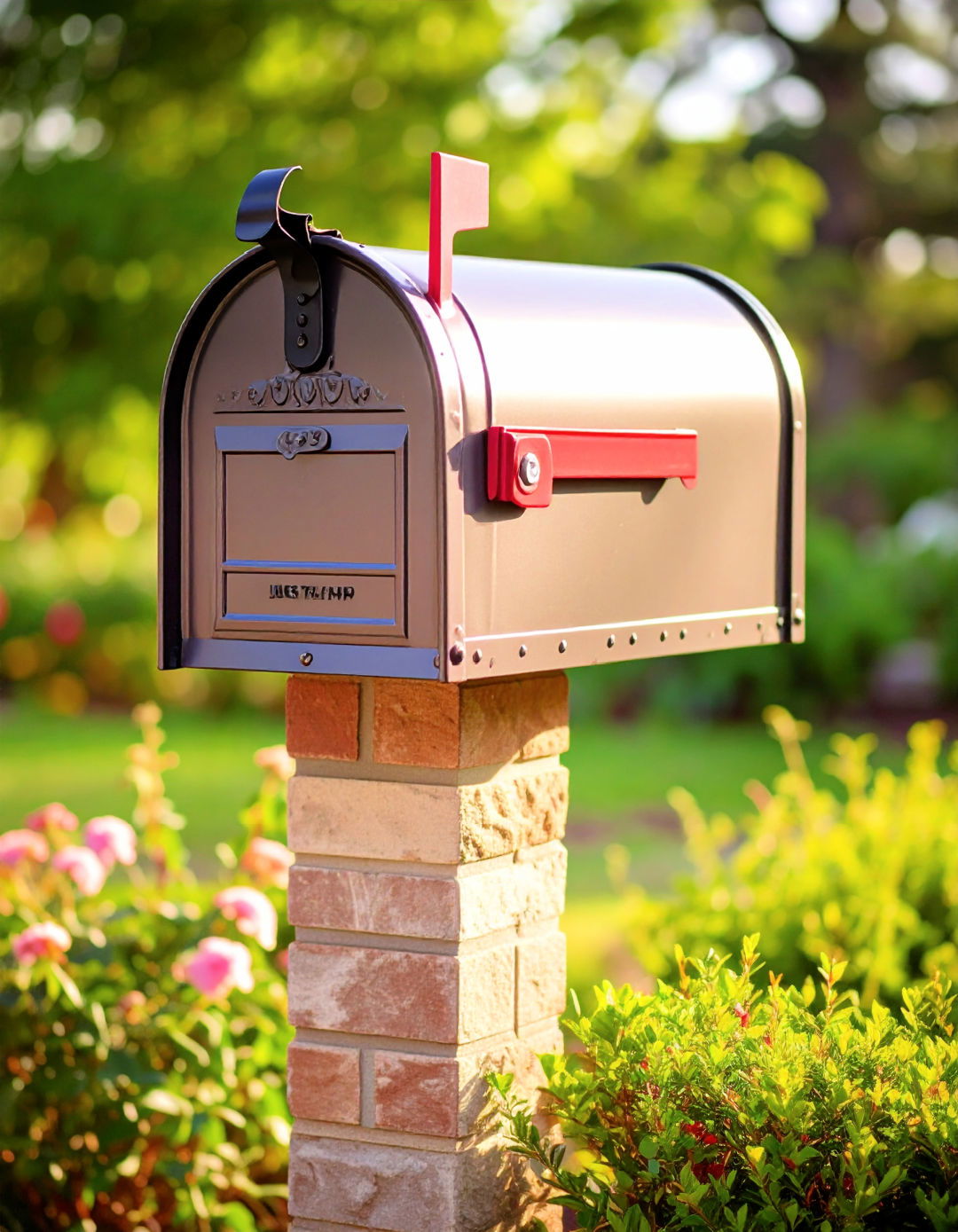
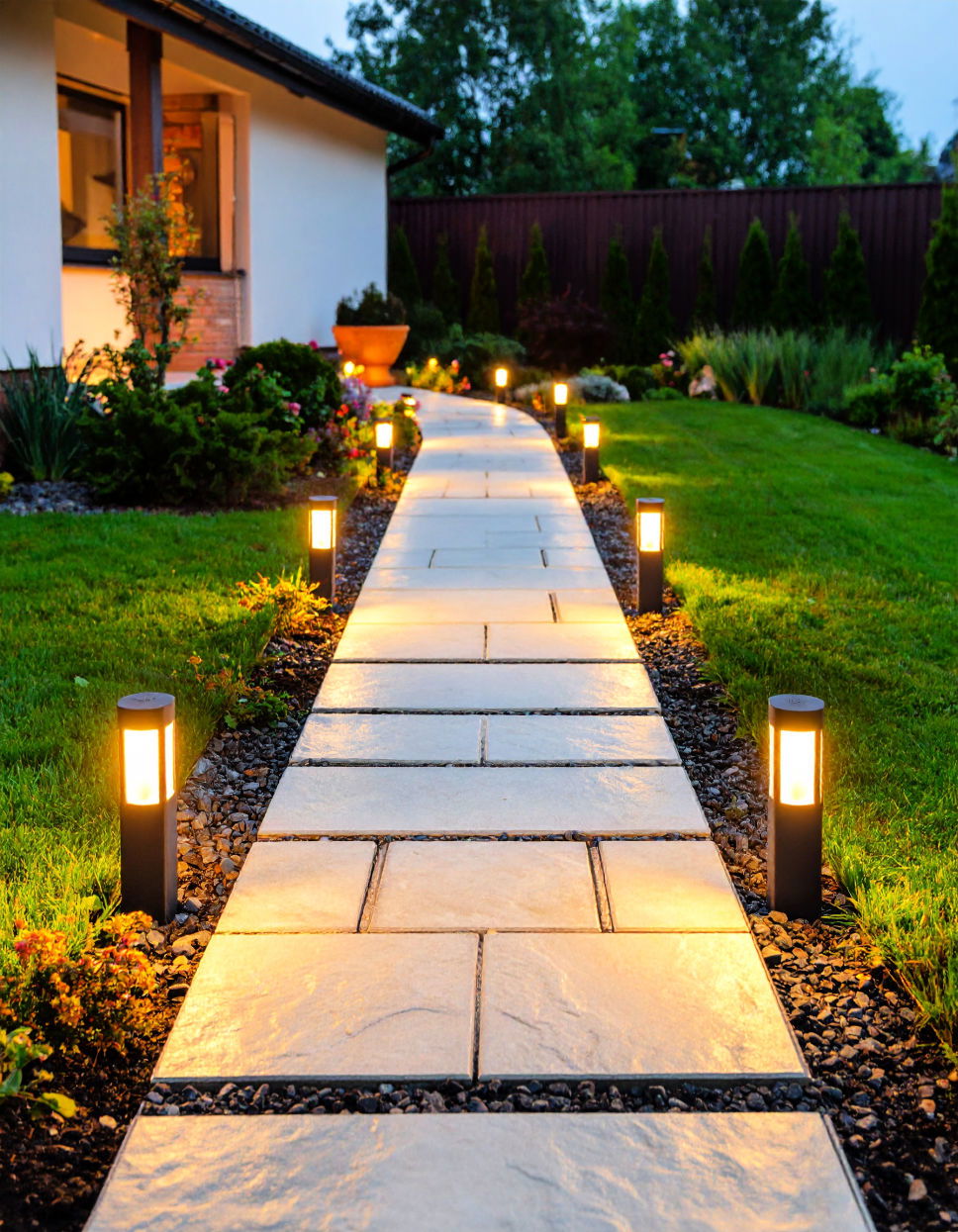
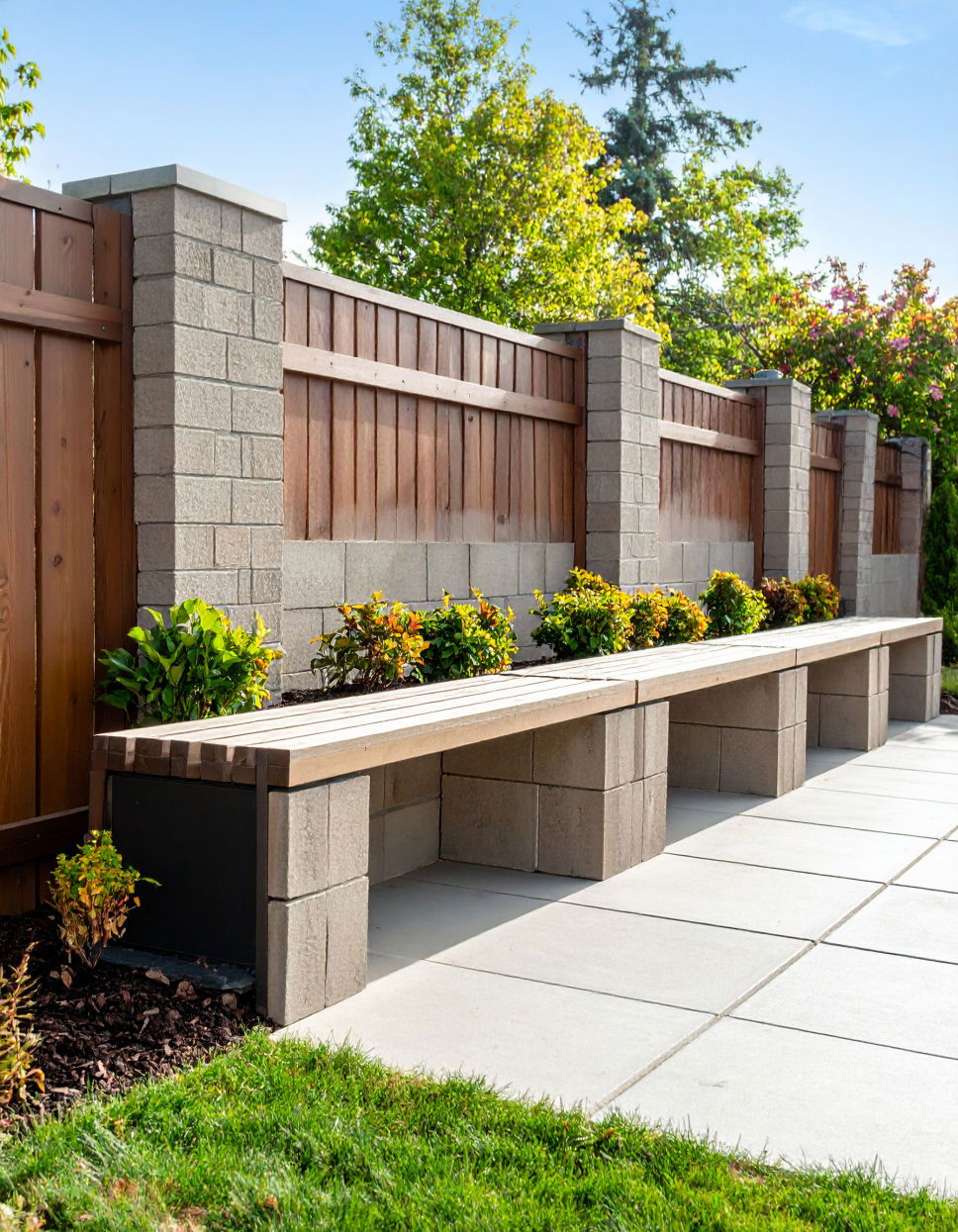
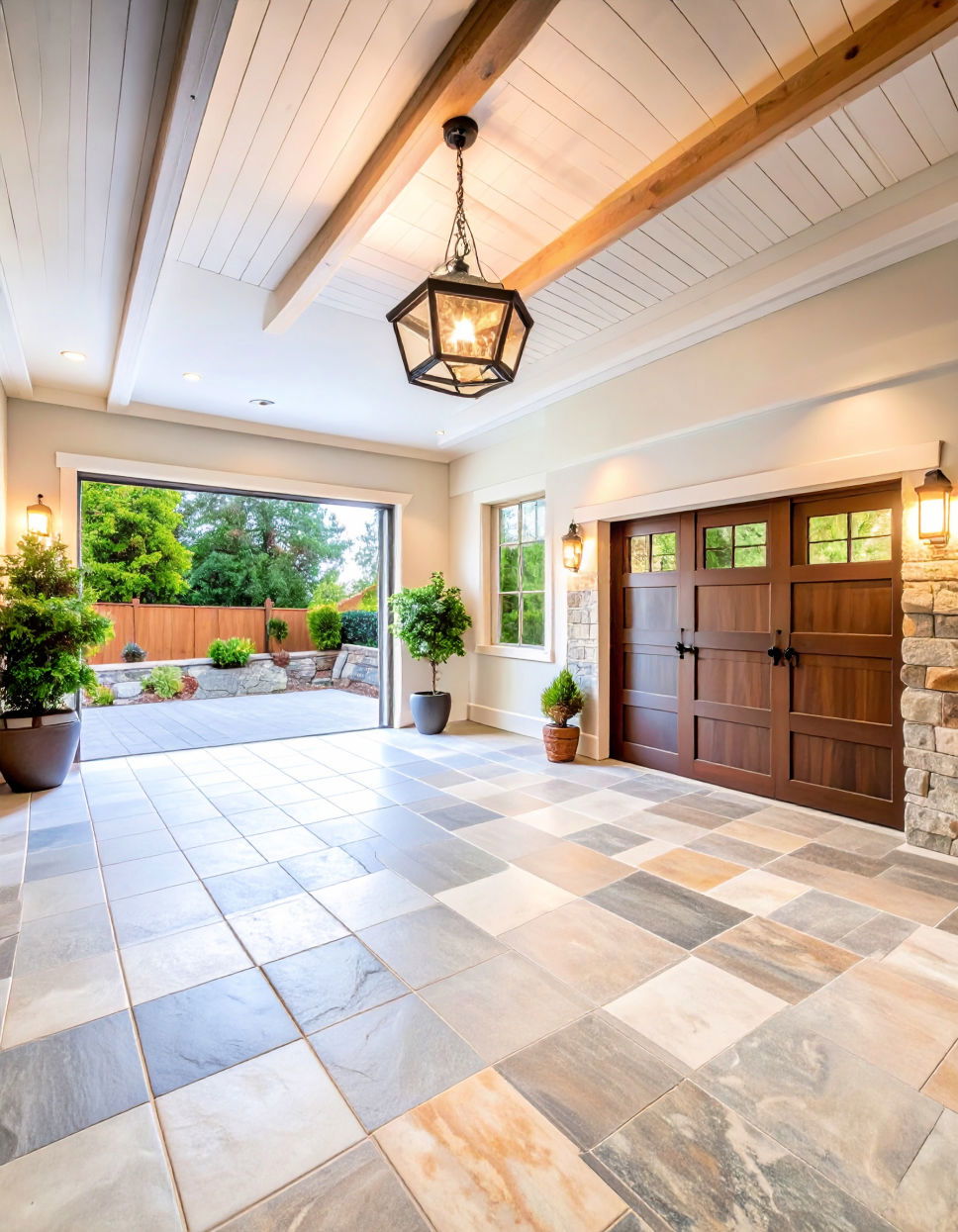
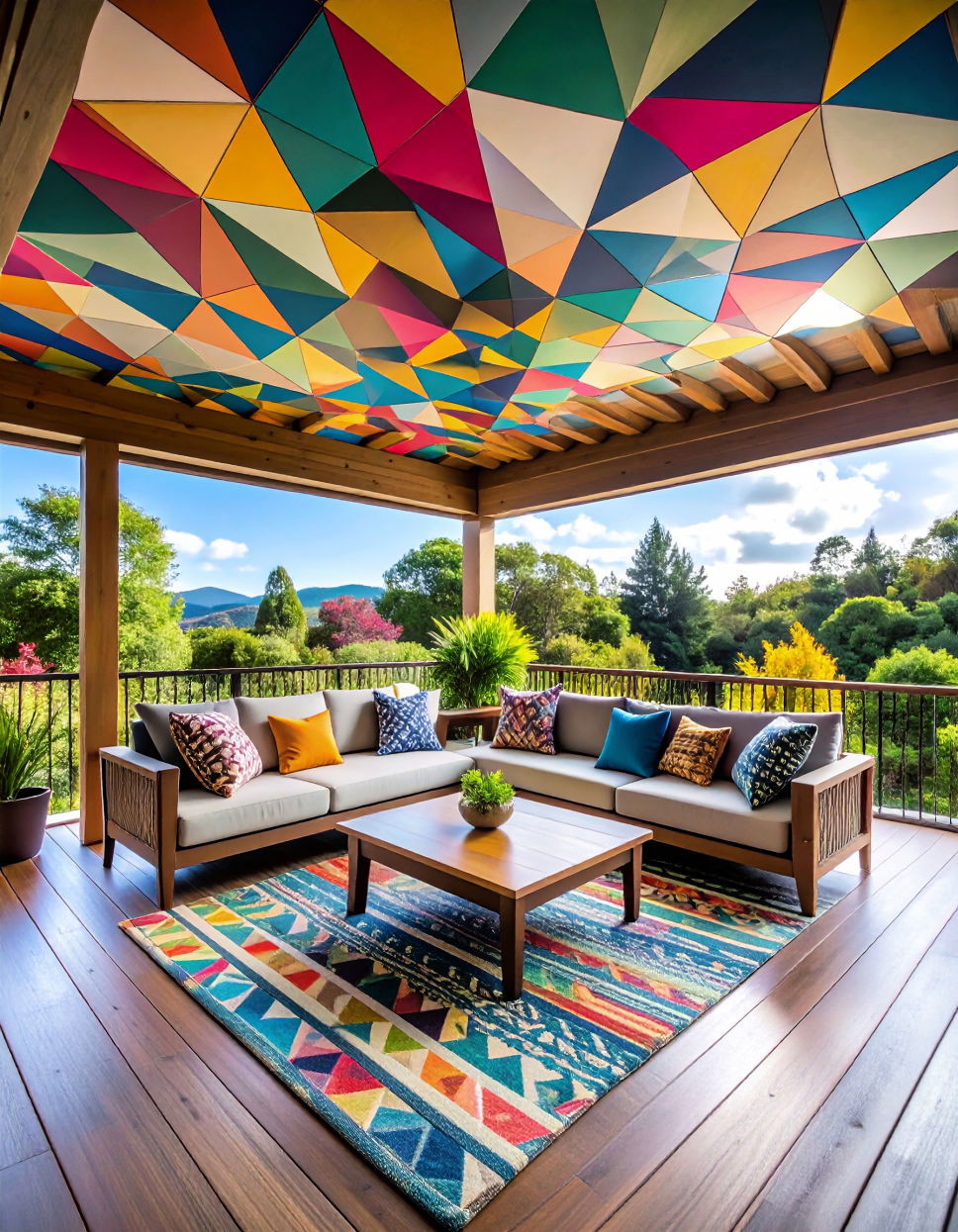
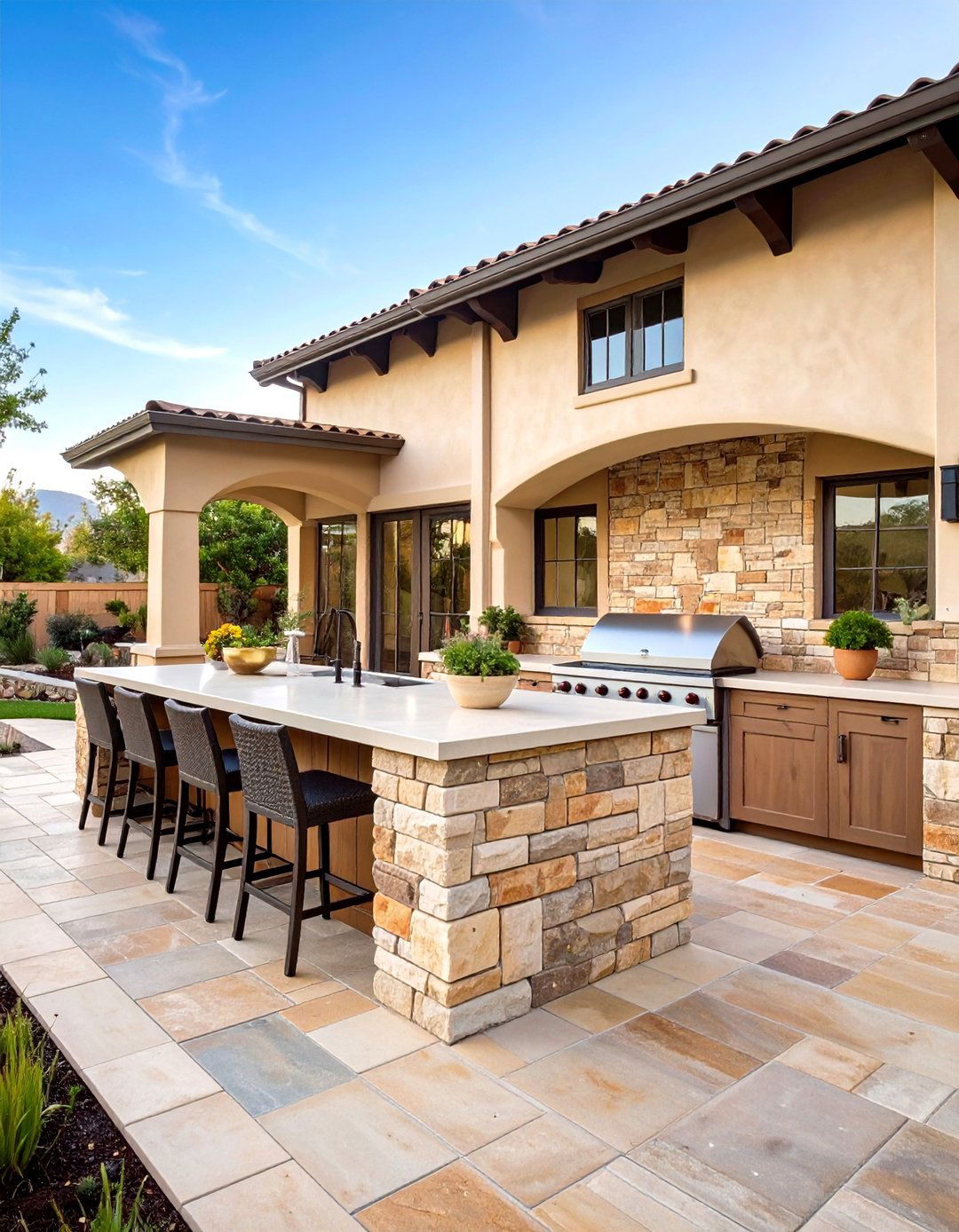
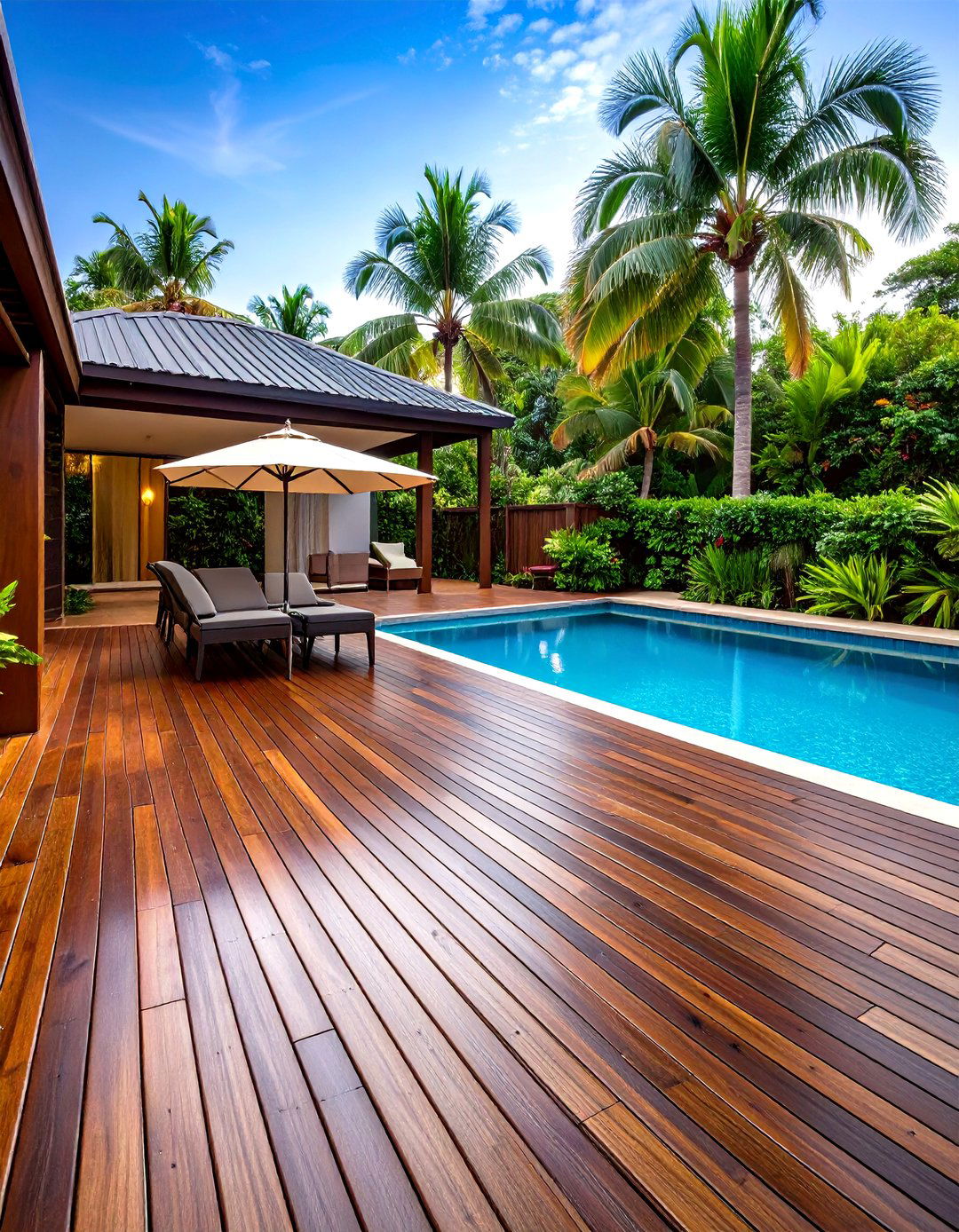
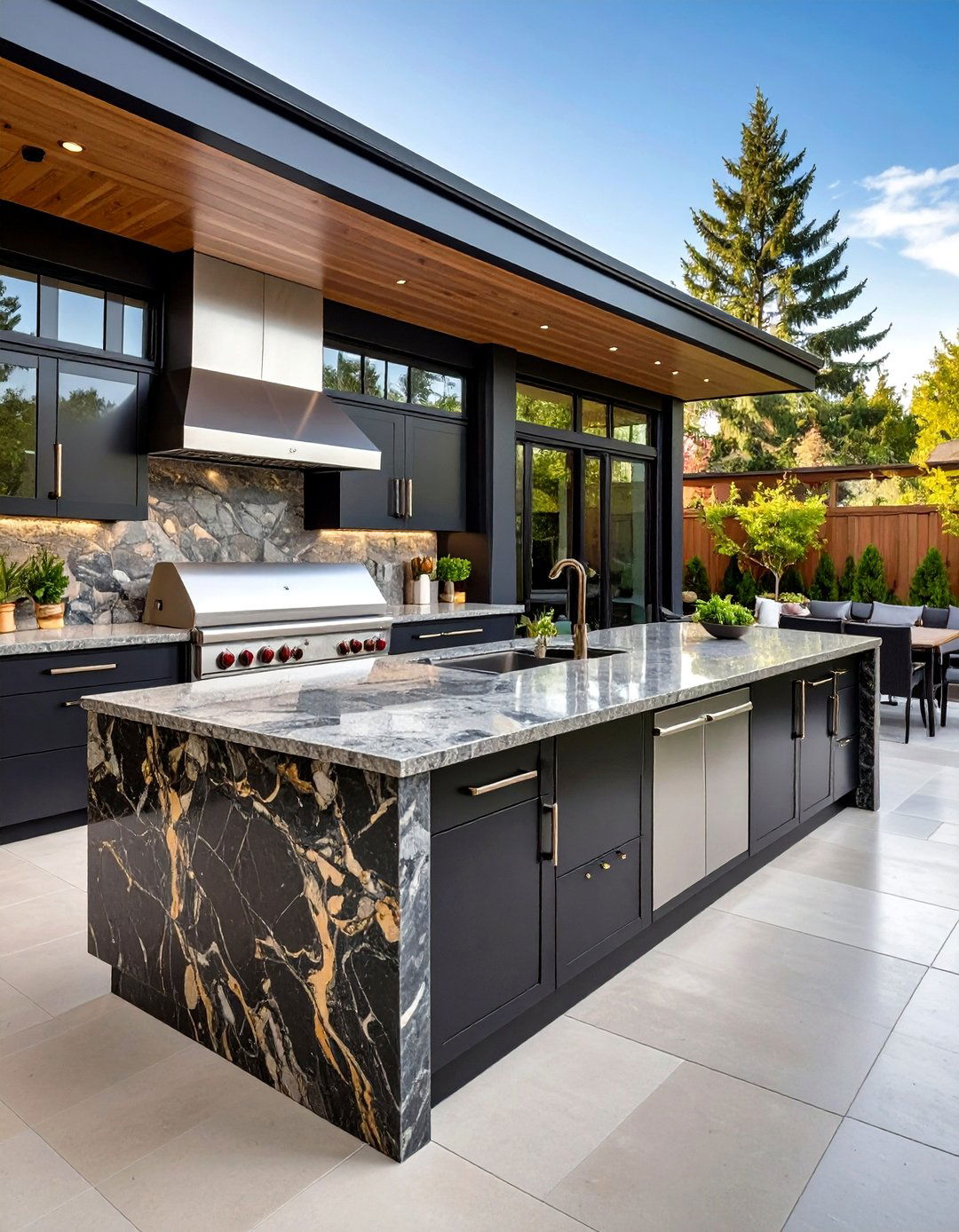
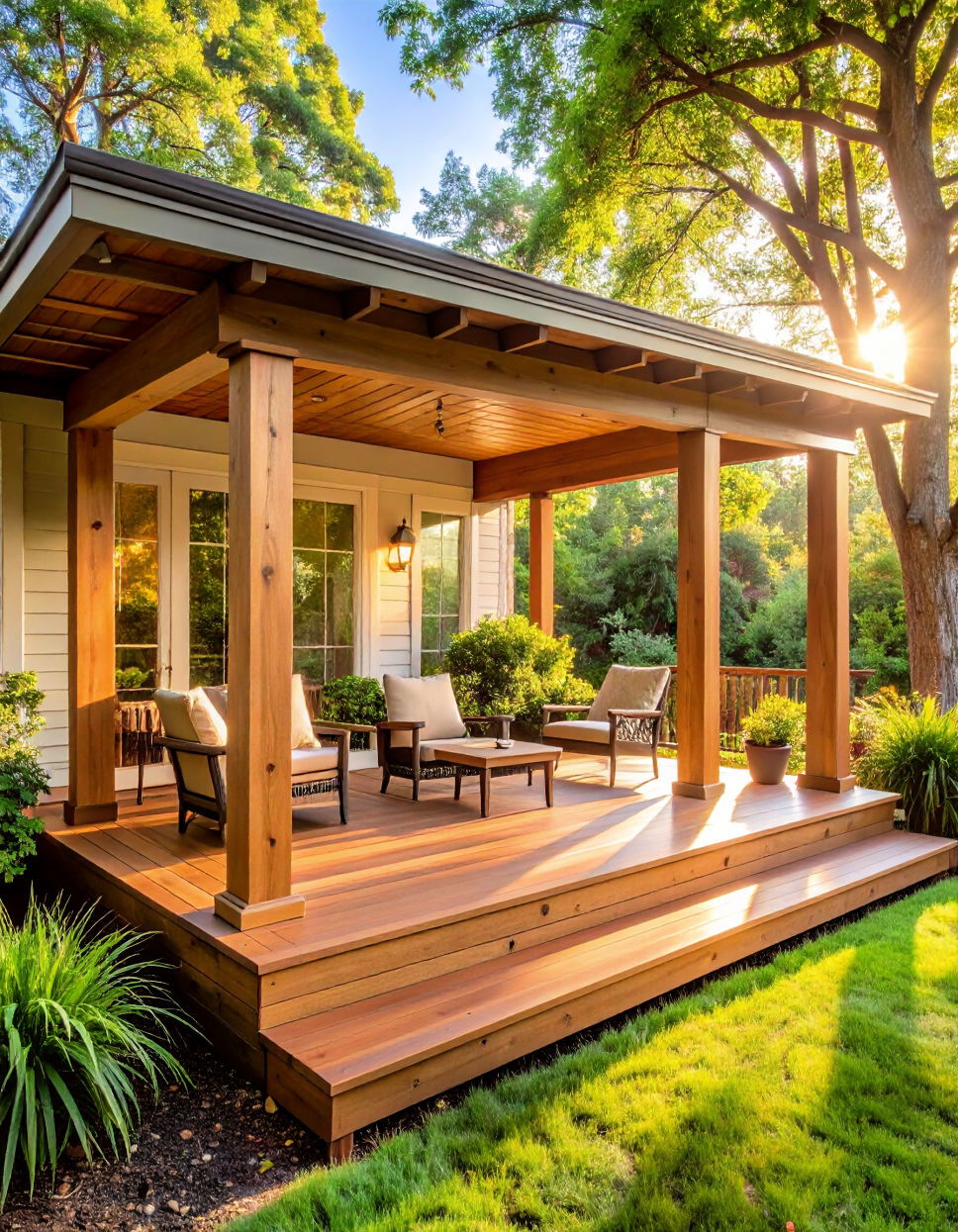
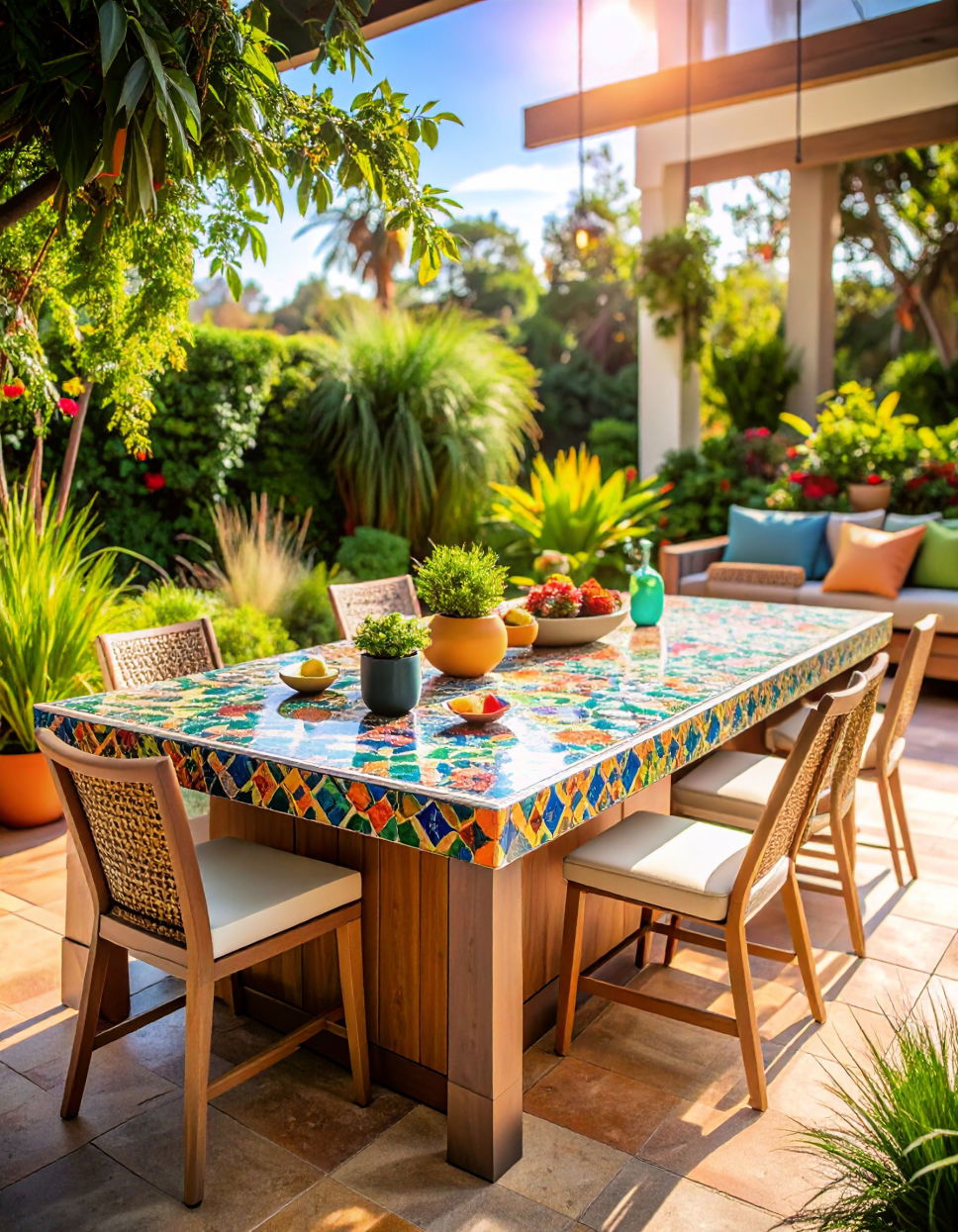
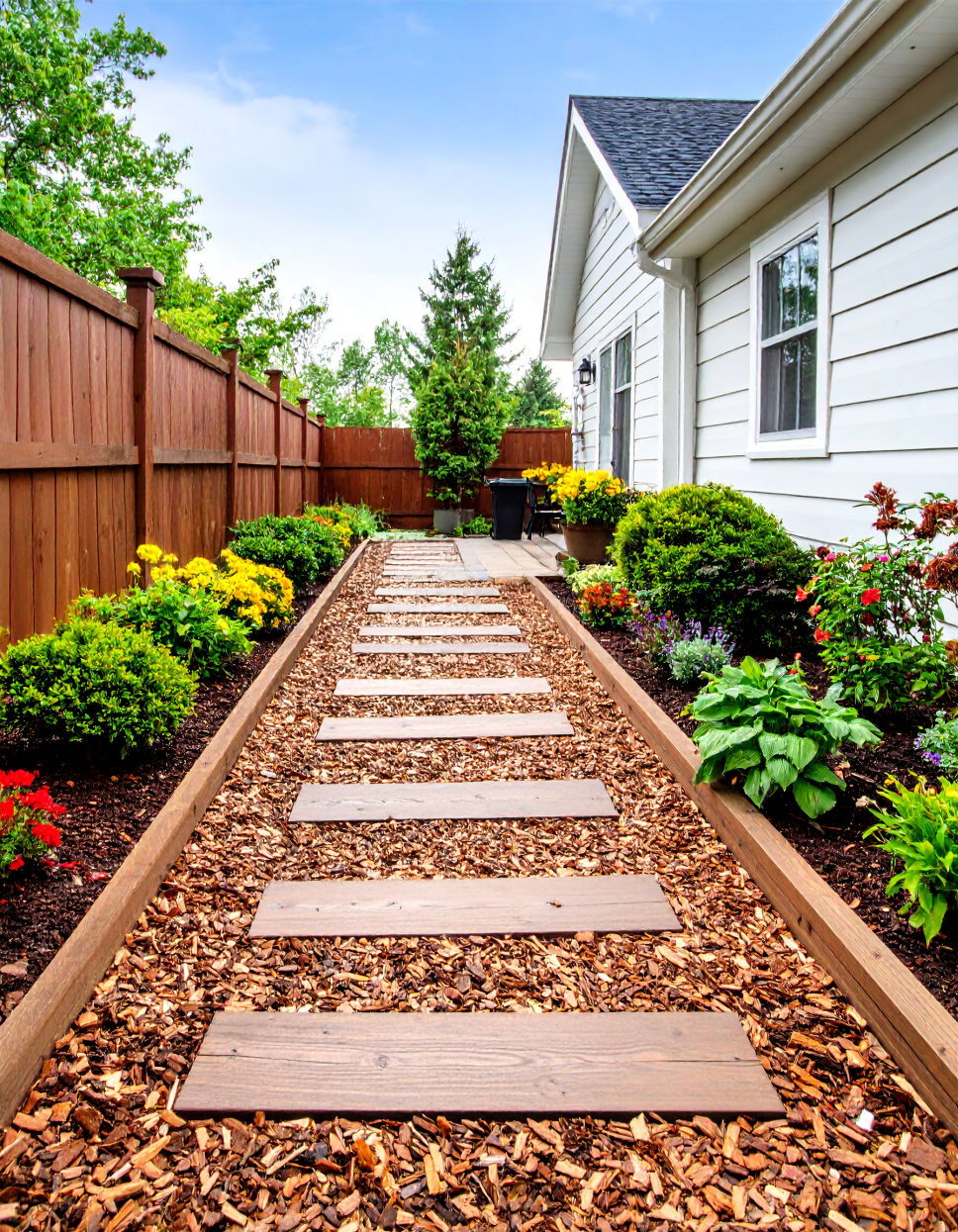
Leave a Reply